Archive for the ‘Habitat Threats’ Category
Friday, August 26th, 2011
 Who does one believe?… Who does one believe?…
Greenwash Tick
.
.
.
Tuesday 23-Aug-2011:
‘Paper manufacturer loses green credentials’
by Liz Hobday, ABC News, 20110823, ^http://www.abc.net.au/news/2011-08-23/paper-manufacturer-loses-green-credentials/2851982/?site=melbourne, accessed 20110825]
.
The Wilderness Society says Australian Paper cannot meet environmental standards. The manufacturer of Reflex paper has lost part of its international environmental certification, after withdrawing from an audit of its wood supplies.

The Forest Stewardship Council was auditing Australian Paper, to check that the wood used to make Reflex paper is not sourced from high conservation value forests.
Luke Chamberlain from the Wilderness Society says the company withdrew from the process, because it cannot meet environmental standards.
“The makers of Reflex paper get their wood from the Victorian State Government native forest logging arm VicForests,” he said.
 “VicForests log in endangered species habitat. They log old growth forests in East Gippsland and the central highlands” “VicForests log in endangered species habitat. They log old growth forests in East Gippsland and the central highlands”
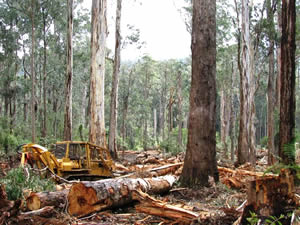
Australian Paper says its products are not sourced from high conservations value forests threatened by logging.
Shaun Scallan from Australian Paper says they withdrew because the audit process changed while it was underway.
“We pulled out because of a change in the definition of part of the standard late in the piece, which did not allow us enough time to then satisfy that changed definition,” he said.
.
.
Meanwhile the same Shaun Scallan of Australian Paper just the day prior on Monday 22 August 2011 posts his media release:
.
‘Australian Paper retains FSC Chain of Custody Certification’…?
by Shaun Scallan, Australian Paper, 20110822, ^http://australianpaper.com.au/media/2478/AP%20FSC%20audit%20release%20FINAL%20Aug%2022_2011.pdf, accessed 20110825
.
‘Australian Paper has successfully retained Forest Stewardship Council (FSC) Chain of Custody certification (FSC-C002059) in its latest audit. Auditor Rainforest Alliance confirmed that under the certification Australian Paper may continue to produce FSC-certified product based on sourcing of material from FSC-certified operations and recycled content, as allowed under the FSC rules for Mixed and Recycled product.
.
“We are pleased to have retained our FSC Chain of Custody certification,” Australian Paper CEO Mr Jim Henneberry said.
“Australian Paper has held Chain of Custody certification since 2006. However, we have decided to remove the Controlled Wood component from our certification at this time as there has been uncertainty around the interpretation of key elements of the standards.”
.
“Advice received by Rainforest Alliance from FSC International around the interpretation of the Standard was received after the physical audit had been completed. This left insufficient time for us to address and so we elected to withdraw Controlled Wood from our certification.” Mr Henneberry said.
.
Australian Paper remains committed to ensuring that fibre supplies come from internationally recognised, third party certified sources and also regards the Australian Forestry Standard and PEFC as benchmark certifications under this policy. The majority of wood supplied to Australian Paper is certified to the Australian Forestry Standard.
.
“We are also continuing to consult with a wide range of stakeholders as part of our Future Fibre Strategy review,” Mr Henneberry said.
“It is vital that we achieve the best balance between the environment, the health of regional communities and our ongoing competitiveness. We look forward to sharing outcomes from this review in due course.”
.
.
Meanwhile, we have the boss of Nippon Paper (the Japanese company that owns the misnomer ‘Australian Paper’) declaring Nippon Paper is going gang-busters to become a top global pulp and paper company…(at any cost?)
 ‘Since I was appointed president of Nippon Paper Group, Inc. in 2008, I have been pursuing “growth-oriented management.” This means exploring every possibility with a consistently positive stance, actively seizing opportunities, achieving the growth needed to become one of the top pulp and paper companies worldwide, as set out in the Group Vision 2015, and developing corporate value that meets the expectations of all stakeholders.’ ~ President of Nippon Paper Group, Yoshio Haga. [Source: ^http://www.np-g.com/e/about/president.html] ‘Since I was appointed president of Nippon Paper Group, Inc. in 2008, I have been pursuing “growth-oriented management.” This means exploring every possibility with a consistently positive stance, actively seizing opportunities, achieving the growth needed to become one of the top pulp and paper companies worldwide, as set out in the Group Vision 2015, and developing corporate value that meets the expectations of all stakeholders.’ ~ President of Nippon Paper Group, Yoshio Haga. [Source: ^http://www.np-g.com/e/about/president.html]
 . .
.
Meanwhile, the stated Charter of Nippon Paper Group includes:
.
‘6. Active involvement with environmental issues assures that…’
.
- ‘We shall promote afforestation projects, to create and make effective use of sustainable forest resources.’
- ‘We shall promote energy conservation, the use of wastepaper and other measures to effectively use resources that are limited in quantity.’
- ‘We shall manage and reduce all types of discharge and waste generated in the course of corporate activities.’
- ‘We shall research and develop manufacturing technologies, and products and services that are in harmony with the environment.’
.
[Source: ^http://www.np-g.com/e/about/charter.html#shead2]
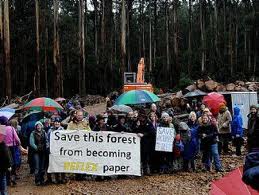
Editor: It is suspicious when a Japanese company is more than content to log and irrevocably destroy another country’s old growth forests, while Japan’s own old growth forests around Mt Fuji remain sacrosanct.
‘In spite of the abundant natural resources, logging is not commonly practiced in the forests of Japan. Japan Forests are venerated and protected since they provide essential soil cover and help in water conservation. All Species are encouraged to grow in the Forests in Japan , from the broad-leaved deciduous to the evergreen coniferous types. There are also many forests which grow near volcanic areas, destroyed and then rejuvenated every time an eruption occurs. The Aokigahara Forest at the base of Mount Fuji is one such forest. Locals as well as tourist camp, trek and hike through these dense forests of Japan to explore their unusual natural beauty.
‘Some Japan Forests are designated as Sacred Forests . These forests generally contain an ancient religious Shrine, usually worshiping the Shinto religion and are protected from trespassing and destruction. These forest shrines are still venerated as national treasures.
.
Some of the sacred forests in Japan are-
- The Forest of the Yahiko Jinja has many trees like the Cedar, Cypress and Oaks. The Shrine has a sacred Chinquapin tree as well.
- The Forest of Atsuta Jinja is an important Shinto Shrine, housing one the three important Shinto relics – the holy sword of Kusanagi-no-tsurugi. The forest has evergreens like the Japanese Camellia Sakaki, camphor trees, Ilex and Japanese Honeysuckle.
- The Forest of Kashima Jingu has over 800 species of trees like varieties of Cedar, Fir and Oak. The Kashima Jingu is an important shrine of the Kanto Area. The forest has been designated as a Wildlife Protection area for the rare birds in the region.
- The Forest of Shimogamo Jinja covers over 495 hectares and has many different species of deciduous trees like the Zelkova, the Elm and the Hackberry. The Shrine itself has 53 buildings which have been designated as National Heritage Architecture.
- The Forest of the Kirishima Jingu covers and area of 887 hectares. Located near the Mount Kirishima Volcano, the forest has been destroyed and then recovered for over 60 times.
- The Forest of the Kasuga Taisha is home to the beautiful podocarpus Nagi. The forest also contains many species of evergreens and shrubs. Trees like the Kasuga, the Andromeda and the Ichii also grow there. People from all over Japan visit the venerated shrine in the quarterly pilgrimages.‘
[Source: ^http://www.mapsofworld.com/japan/japan-tourism/forests-in-japan.html]
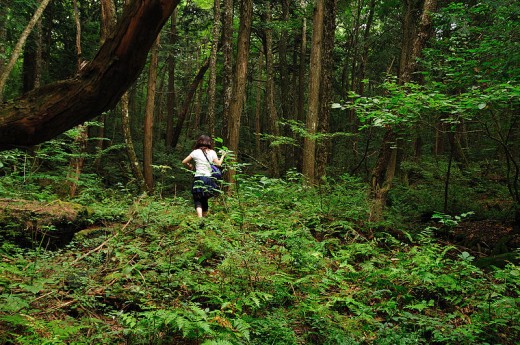 Japan’s sacred Aokigahara Forest Japan’s sacred Aokigahara Forest
.
Ethics question for Yoshio Haga (President of Nippon Paper Group):
What moral right do the Japanese have to consider their own native old growth Aokigahara Forest more sacred than Australia’s sacred native old growth forests such as those across East Gippland?
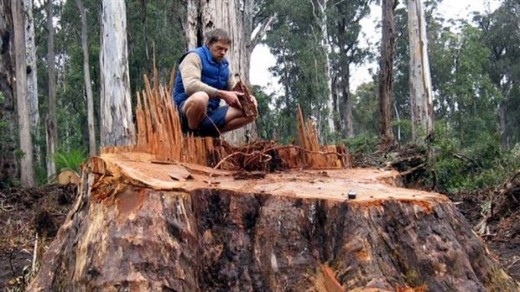 Stump of Brown Mountain’s sacred 600 year old Mountain Ash old growth tree.
It was logged by VicForests in November 2008 for Nippon Paper’s Reflex Paper. Stump of Brown Mountain’s sacred 600 year old Mountain Ash old growth tree.
It was logged by VicForests in November 2008 for Nippon Paper’s Reflex Paper.
.
.
In light of VicForests recent civil prosecution in the Victorian Supreme Court, Nippon Paper Group’s association with VicForests calls into question the reputation of Nippon Paper Group and its brand Reflex Paper:
.
‘VicForests has been stopped from harvesting certain coupes in the Brown Mountain forest in East Gippsland containing old growth forest
– habitat for rare and threatened species – until the completion of steps implementing the precautionary principle.’
.
.
.
‘Environment East Gippsland Inc v VicForests – The precautionary principle in action’
22 November 2010:
[Source: Blake Dawson (Lawyers), ‘Environment Matters’, 20111122, ^http://www.blakedawson.com/Templates/Publications/x_article_content_page.aspx?id=60457, accessed 20110825]
.
.
In Brief:.
- ‘The Victorian Supreme Court decision in Environment East Gippsland Inc v VicForests firmly embeds the approach to the precautionary principle laid down in Telstra Corporation Limited v Hornsby Shire Council (2006).’
- ‘The case makes it clear that the precautionary principle can be the subject of an enforceable obligation.’
- ‘The case also makes it clear that the precautionary principle applies both at the strategic and operational stages of a project or undertaking.’
- ‘The fact that VicForests complied with its forestry approvals was not enough to satisfy the Court that it had met its obligations with regard to the precautionary principle.’
.
‘In Environment East Gippsland Inc v VicForests [2010] VSC 335 conservation group Environment East Gippsland (EEG) won a landmark injunction against VicForests, a state-owned timber business with responsibility for commercial timber harvesting in Victoria’s state forests.
VicForests has been stopped from harvesting certain coupes in the Brown Mountain forest in East Gippsland containing old growth forest – habitat for rare and threatened species – until the completion of steps implementing the precautionary principle.
In this case, Justice Osborn of the Supreme Court of Victoria undertook a thorough analysis of the application of the precautionary principle in the context of a detailed legislative regime aimed at balancing biodiversity protection and commercial timber harvesting. The case embeds the approach to the precautionary principle laid down by Chief Justice Preston of the Land and Environment Court of New South Wales, in Telstra Corporation Limited v Hornsby Shire Council (2006) 67 NSWLR 256.’
.
The lead-up to the litigation
.
‘The Brown Mountain forests in Victoria’s East Gippsland contain old growth forests and provide habitat for rare and threatened species such as the Powerful Owl, the Spotted-tailed Quoll (mainland Australia’s largest marsupial carnivore) and the Long-footed Potoroo. However, these areas are also amongst the most productive timber harvesting forests in Victoria and play a crucial role in Victoria’s sustainable timber industry.
In 2006, the Victorian State Government committed to increasing the conservation parks and reserves within the broader Brown Mountain area. Nevertheless, in 2008 commercial logging in the Brown Mountain area began.
After numerous studies of the area indicated the presence of important threatened and rare species, EEG requested the Minister for Environment and Climate Change, Gavin Jennings, to make an interim conservation order to conserve critical habitat of the endangered Long-footed Potoroo, Spot-tailed Quoll, Sooty Owl, Powerful Owl and Orbost Spiny Crayfish at Brown Mountain. The Minister did not grant a conservation order, but instead increased the conservation area surrounding Brown Mountain.
Having failed to obtain undertakings from VicForests that it would not proceed to log the Brown Mountain coupes, EEG sought interlocutory injunctive relief. An interlocutory injunction restraining logging was granted by Justice Forrest on 14 September 2009 (see our article Environmental litigation heats up with some significant wins for public interest litigants in our 2 October 2010 edition of Environment Matters ), pending the outcome of the full proceedings before Justice Osborn in the Supreme Court of Victoria.’
.
The legislative regime
.
‘Logging of state forests in Victoria is regulated by a complex scheme of legislation, codes of practice, management plans and procedures, described by Osborn J as “labyrinthine”. The principal legislation includes the Forests Act 1958 (Vic) (Forests Act), Sustainable Forests (Timber) Act 2004 (Vic) (SFT Act), Flora and Fauna Guarantee Act 1988 (Vic) and Conservation, Forests and Lands Act 1987 (Vic).’
.
Responsibilities for timber harvesting and forestry management
.
‘VicForests is a state-owned corporation, established in 2004 to undertake the harvesting of timber in Victoria’s state forests. The Secretary to the Department of Sustainability and Environment (DSE) has overarching responsibility for managing state forests and timber harvesting within forests under the Forests Act.’
.
Legal challenge
.
‘EEG sought an injunction restraining VicForests from harvesting four coupes at Brown Mountain containing old growth forest. It also sought declarations that timber harvesting within the coupes by VicForests in accordance with the current forestry regime would be unlawful.
EEG argued that the current conservation measures for the Brown Mountain coupes did not meet the requirements of the regulatory system, which addresses the preservation of conservation values and in particular the protection of endangered species. EEG also argued that VicForests had failed to implement the precautionary principle.
VicForests took issue with EEG’s standing to sue. Further, it denied the presence of a number of endangered species and argued that the logging of the Brown Mountain coupes would take place under a legislative framework that adequately protects endangered species and would, therefore, be lawful. It also argued that it was DSE’s responsibility to stipulate any further requirements for habitat protection in accordance with the regulatory regime.’
.
EEG’s standing
.
‘Following the settled High Court authority that standing to bring such proceedings depends on the plaintiff’s “special interest” in the subject matter of the litigation (Australian Conservation Foundation v Commonwealth (2000) 200 CLR 591), Osborn J was satisfied that EEG had a relevant “special interest” because:
- EEG uses the coupes to a greater degree than the general public (for example, the group has a “Valley of the Giants Old Growth Forests Walk” through the affected coupes);
- EEG’s predecessor was involved in the consultative process for the formulation of the applicable forest management plan; and
- the government has previously recognised EEG’s status as a body representing this sector of the public interest.’
.
The precautionary principle [Ed: once again]
.
‘The VicForests case firmly embeds in Australian environmental jurisprudence the approach to the precautionary principle laid down by Chief Justice Preston of the Land and Environment Court of New South Wales, in Telstra Corporation Limited v Hornsby Shire Council (2006) 67 NSWLR 256 (Telstra). Justice Osborn’s decision in VicForests is the first Supreme Court application of the Telstra principles.
The precautionary principle is integrated throughout the Victorian forestry regime’s many instruments.
Following Preston CJ’s two-fold test in Telstra, Osborn J stressed that the precautionary principle is a test of common sense. There must be:
- a threat of serious or irreversible environmental damage; and
- scientific uncertainty as to the environmental damage.
Justice Osborn stated:
Once both of these conditions or thresholds are satisfied, a precautionary measure may be taken to avert the anticipated threat of environmental damage, but it should be proportionate … [The] degree of precaution appropriate will depend on the combined effect of the seriousness of the threat and the degree of uncertainty.
It is a “wherever practicable” test.
In practice, this meant that once the two-fold test was satisfied by EEG, VicForests had the onus of proving that the threat posed by logging the coupes did not exist or was negligible. Because it could not do this, the question then became:
- whether the threat was able to be addressed by adaptive management measures (in this case the requirement for surveys and management zone reviews); and
- whether the measure alleged to be required (here the permanent injunction against logging the coupes) was proportionate to the threat in issue.
Justice Osborn carefully examined the legislative regime and held that it is not intended that VicForests only apply the precautionary principle at the strategic planning stage:
VicForests is specifically required to apply it [the precautionary principle] having regard to the results of monitoring and research as they come to light during operations. … The requirements of the precautionary principle fall to be considered in the light of the whole of the evidence bearing on these matters as it now is and not as it was at the time VicForests completed planning.
Justice Osborn stressed, however, that the precautionary principle sits within a wider statutory regime that takes into account principles of sustainable development.
He held that unless VicForests complied with the requirements of the applicable Flora and Fauna Guarantee Act Statements and with conditions stated in the relevant allocation order (under the Forests Act) and the Timber Release Plan (under the SFT Act), logging at Brown Mountain would be unlawful.
This meant that VicForests could not rely on its current approvals to log the coupes because DSE had not, for example, changed zonings in the coupes to reflect the presence of threatened species. VicForests had an ongoing, active duty to apply the precautionary principle, which included responding to new information as it became available.
Importantly, Osborn J stressed that the precautionary principle can be the subject of an enforceable obligation.’
.
Outcome
.
‘Justice Osborn ordered that VicForests stop harvesting until various measures had been completed to respond to the detection of endangered species and to implement a precautionary approach with respect to their potential extinction. The required measures included:
- creating or amending special management zones, special protection zones and retained habitat areas to protect the Long-footed Potoroo, Greater Gliders and Yellow-bellied Gliders (as relevant);
- undertaking further surveys for the Giant Burrowing Frog, Large Brown Tree Frog and Spotted-tailed Quoll; and
- completing a current review of the Powerful Owl and Sooty Owl Management Areas,
to the satisfaction of the Director, Biodiversity Policy and Programs, DSE.
The difficulty for the Court in formulating its orders was that the power to act on the evidence of rare and endangered species and implement the required legislative and policy changes lies not with VicForests, against whom the injunction was sought, but with DSE.
Justice Osborn overcame this difficulty by stopping VicForests from logging until certain actions are undertaken, these actions being DSE responsibilities. VicForests had maintained throughout proceedings that it would comply with any changes to the regulatory regime made by DSE, and this was accepted by the Court.
.
Significance of the decision
.
This case firmly embeds the approach to the precautionary principle laid down by Chief Justice Preston in Telstra Corporation Limited v Hornsby Shire Council (2006) 67 NSWLR 256.
Justice Osborn’s decision makes it clear that:
- The precautionary principle can be the subject of an enforceable obligation.
- Parties having an obligation to apply the precautionary principle cannot demonstrate compliance with the principle solely through departmental approval of their actions or relevant approvals under the regulatory regime; the precautionary principle is an active obligation that applies throughout operations, requiring parties to respond to new information as it arises.
- The precautionary principle applies throughout all stages of operation, not just the strategic planning (or approvals) stage.
The decision has broader implications because:
- The precautionary principle is embedded in many other statutory regimes in Victoria and around Australia, apart from the Victorian legislative regime for forestry and the protection of endangered species. The decision has implications for any statutory regime in which the principle is enshrined.
- Although VicForest is a state-owned enterprise operating within a highly regulated environment, there is scope for the decision to be applied to other types of entities operating within industries where the precautionary principle is relevant.
Furthermore, a decision of the Supreme Court of Victoria has strong precedent value, and is likely to be adopted by the Supreme Courts of other States, and perhaps even higher courts or courts with federal jurisdiction.
.
Action points
.
Parties under an obligation to apply the precautionary principle need to be aware that:
- to implement the precautionary principle as per the principles laid down in Telstra, parties need to ask:
- is there a real threat of serious or irreversible damage to the environment?
- if yes, is it attended by a lack of full scientific certainty (in the sense of material uncertainty)?
- if yes, is the threat non-existent or negligible?
- if no, is the threat able to be addressed by adaptive management and is the measure alleged to be required proportionate to the threat in issue?
- the principle must be applied at both the strategic decision making stage of a project, and throughout the operational stage; and
- it may not be sufficient to simply obtain and comply with project approvals – parties need to proactively respond to new information as it arises throughout the operational stage.’
.
..
.
Further Reading:
.
[1] >Vicforests’ Ecological Genocide
.
[2] ‘Nippon buys Maryvale mill‘, by Ian McIlwraith, The Age newspaper, 20090217, ^http://www.theage.com.au/business/nippon-buys-maryvale-mill-20090216-89bu.html, accessed 20110826]
.
‘Paperlinx will take a $600 million hit on its half year results and the future of its Tasmanian operations is under review after last night unveiling the partial sale of its Australian papermaking business.
Japan’s Nippon Paper Group will buy most of Australian Paper, which includes the Maryvale pulp mill in Gippsland, for more than $700 million, including taking on attached debt and a three-year profit share agreement.
Money from the sale, expected to be completed in June, will go to reducing PaperlinX’s debt burden to about $340 million…’
[Editor: So Paperlinx was in debt to the Australian Tax Office by over a billion dollars? How can Australia’s pulp industry be profitable then?]
.
[3] Australian Paper Watch website (providing information about the logging of Victoria’s forests to make paper products such as Reflex by Nippon Paper and their ‘subsidiary’ Australian Paper), ^http://www.australianpaper.forests.org.au/
.
[4] Nippon Paper’s Maryvale Mill Upgrade, ^http://www.reflex.com.au/2008-Maryvale-Mill-Upgrade/
‘Australian Paper has a long history in the La Trobe Valley in Gippsland, Victoria, dating back to 1937 when established. Today, the Mill is Australia’s largest integrated pulp and paper operation. In response to global paper trends and changing consumer expectations for our products, Australian Paper (Nippon Paper subsidiary) embarked on a major upgrade of the Maryvale Pulp Mill in 2006 which was completed in December 2008. With an investment of $350 million, the upgrade significantly expanded the Mill’s production of bleached pulp capacity and delivered a range of safety, health and environmental benefits.’
.
[5] ‘Loggers, activists clash over forest‘, by Adam Morton, The Age newspaper, 20110817, August 17, 2011, ^http://www.theage.com.au/victoria/loggers-activists-clash-over-forest-20110816-1iwew.html
.
‘Conservationists have held up timber workers in a fiercely contested area of native forest on Melbourne’s fringe for nearly a month, chaining themselves to bulldozers and climbing trees scheduled for logging.
The protest, which has led to at least 10 arrests, is expected to reach a climax today as activists and local residents march into the logging coupe outside Toolangi in Victoria’s central highlands.
Protest organisers claim they have evidence the coupe is home to the endangered Leadbeaters Possum, which scientists say is under threat after Black Saturday bushfires wiped out up to half its habitat. But the Department of Sustainability and Environment says there has been no sign of live possums. Department spokeswoman Kim Payne said one tree in the coupe had hollows that showed evidence of possum use. That tree would be left standing, but the coupe did not meet the legal criteria of prime possum habitat and could otherwise be logged.
Sarah Rees, director of Healesville-based group My Environment, said it was cruel to think a possum could be protected by retaining a single tree while taking away the forest around it. She said logging was hurting central highlands communities.
.
”Tourism based on the state forest is far more important to the local economy than forestry and the two cannot co-exist,” she said.
The conflict over the Toolangi State Forest was the focus of a public meeting in the area late last week when logging opponents verbally clashed with forestry workers, who accused the activists of restraint of trade. One contractor said he had lost about $80,000 due to the protests.
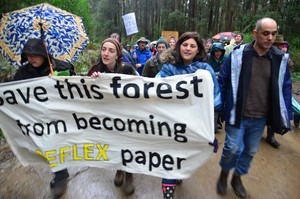
David Walsh, spokesman for state commercial timber agency VicForests, said the Toolangi protests had cost forest workers significant time. Only about a quarter of the 19-hectare coupe had been harvested. He said gates raised to ensure public safety had been damaged. ”VicForests believes these are legal harvesting operations which comply with the detailed legislative framework governing native timber harvesting in Victoria,” he said.‘
.
Editor: The legal doctrine of ‘restraint of trade’ sought to be applied in the commercial exploitation and destruction of old growth forests, is an invalid excuse. It is a contemptible euphemism for a ‘right to rape’ old growth ecology that is being contrived by commercial lawyers profiting from the exploiters ~ a case of the morally bankrupt collaborating with the damned.
[6] Ethical Paper website, ^http://www.ethicalpaper.com.au/
.
[7] My Environment website, ^http://www.myenvironment.net.au/
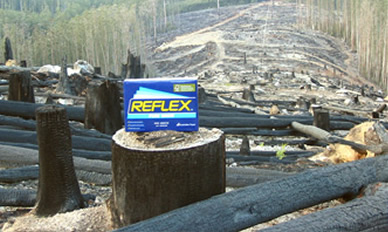
.
– end of article –
Tags: Aokigahara Forest, Atsuta Jinja, Australian Forestry Standard, Australian Paper, Chain of Custody certification, deforestation, East Gippsland, EEG, endangered species habitat, Environment East Gippsland, Environment East Gippsland Inc v VicForests, Flora and Fauna Guarantee Act, Forest Stewardship Council, Forestry Standard Certification, FSC, FSC audit process, FSC Chain of Custody Certification, FSC International, FSC-C002059, Future Fibre Strategy, Giant Burrowing Frog, Greater Glider, Greenwash Tick, Kashima Jingu, Kasuga Taisha, Kirishima Jingu, Large Brown Tree Frog, Leadbeaters Possum, Logging, Long-footed Potoroo, Maryvale Pulp Mil, My Environment, Nippon Paper Group, PEFC, Powerful Owl, precautionary principle, pulp and paper, Rainforest Alliance, Reflex Paper, restraint of trade, right to rape, sacred forest, Shimogamo Jinja, Shinto religion, Sooty Owl, The Wilderness Society, Timber Release Plan, Toolangi State Forest, TWS, VicForests, Yahiko Jinja, Yellow-bellied Glider
Posted in Gippsland (AU), Owls, Potoroos, Quolls, Reptiles, Threats from Deforestation | No Comments »
Add this post to Del.icio.us - Digg
Thursday, August 25th, 2011
The following article was initially published by The Wilderness Society (NSW) on its website 20110729. Reproduced with permission from The Wilderness Society (NSW):
 A dying river near Broken Hill, NSW (not so long ago) A dying river near Broken Hill, NSW (not so long ago)
is visited by Chris Daley, the Wilderness Society rivers campaigner.
Photo by Dean Sewell
.
Despite common perceptions, the problems facing the Murray-Darling Basin are not confined to rural communities, and their social implications are extensive.
Adelaide, for example, relies on the Murray-Darling to provide around 55% of its drinking water. In fact, more than four million people depend on the Basin for water. But the future of the Murray-Darling and its communities are under threat from over-extraction of water, salinity and climate change. The Basin supports diverse communities that have grown up on the river, and who consider it to be central to their way of life. Locals see the river as extremely important from a social point of view, as Barney Stephens from the Darling River Action Group pointed out.
“The lakes and the Darling River and the Anabranch are basically Broken Hill’s recreation. People think of recreation as something that’s maybe not essential, but when you look at an isolated town like Broken Hill, if you take the lakes away and the rivers away it’s like taking the beaches away from Sydney.”
Dr. James Pittock, Programme Leader of Australian and United States Climate, Energy and Water at the US Studies Centre, Australian National University, agrees that returning water to the Basin is socially and economically important.
.
Multiple Benefits
.
“The water in the Murray-Darling Basin provides lots of different benefits for people, and many of those benefits are gained from leaving water in the river, in terms of providing habitat for fish right through to the Lower Lakes and Coorong near the sea where [there are] massive fishing industries, both commercial and recreational”, said Pittock.
Both men also point to the cultural significance of the river to aboriginal people that have lived by the river for thousands of years. “Most of them [in the Broken Hill area] were Paakantji, which means ‘river people’, and the river is just essential to them,” said Stephens.
While irrigators have argued that the Basin Plan has the potential to damage rural communities, Dr. James Pittock says the social consequences of not returning health to the river will be far worse.
“If this Basin Plan isn’t implemented well, that is if the reform isn’t substantial in quickly reallocating a lot of water from agriculture to the environment, we risk another crisis in a few years time.”
.
Best chance in a generation
.
“We will be back to this public dispute over water allocation…and eventually industry will be forced to cut back to sustainable levels. Now the question for the industry is, do you want to do that now, and do it with some certainty so that rural communities can get on with planning a more sustainable future? Or alternatively, if this opportunity for reform is fudged in some political compromise, do you really want to live with the uncertainty of repeating the exercise every five to ten years when the next drought hits?”
Right now, the Government and the Murray-Darling Basin Authority (MDBA) have a responsibility to rectify these problems once and for all in the development of the Murray-Darling Basin Plan. To do so, they must commit to buying back 7,600 gigalitres of water to be returned to the system. This was the scenario identified in the MDBA’s Guide to the proposed Basin Plan as carrying the least risk of irreversible damage to the river system.
The Wilderness Society is urging the Australian Government to spend the $10 billion of taxpayers’ money allocated to save the Basin wisely, or give the Australian public their money back. Responsible and scientifically based action to ensure the sustainability of the Basin will help to build stronger, more diverse rural communities.
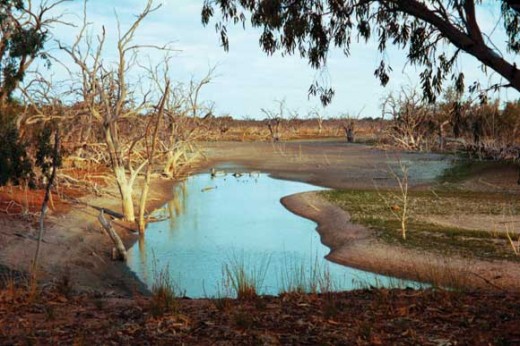 Menindee Lakes —inlet to Lake Cawndilla during drought in 2003 Menindee Lakes —inlet to Lake Cawndilla during drought in 2003
(MDBC Annual Report 2003-04, Photo: L. Palmer)
.
.
.
Further Reading:
.
[1] Jamie Pittock BSc. Hons (Monash), PhD (ANU) is ‘Director of International Programs for the UNESCO Chair in Water Economics and Transboundary Water Governance, Program Leader, Australia and United States – Climate, Energy and Water, US Studies Centre and ANU Water Initiative. Jamie Pittock is Director of International Programs for the UNESCO Chair in Water Economics and Transboundary Water Governance. His current work includes developing research programs that link Australian and southern African expertise to improve management of river basins, green water and agriculture. He is also Program Leader for the Australia and United States – Climate, Energy and Water project of the US Studies Centre and ANU Water Initiative. [Read More].
[2] Darling River Action Group, ^http://www.d-r-a-g.org.au/
[3] Paakantji, ^http://www.curriculumsupport.education.nsw.gov.au/secondary/languages/languages/aboriginal/campfire/stories/paakantji/paakantji_stories.htm
[4] The Wilderness Society (NSW), River Protection Campaigns, ^http://www.wilderness.org.au/campaigns/river-protection
[5] ‘Living Murray, Dying Darling – the year our fish died and Broken Hill cried,’ speech by Joe Flynn, Managing Director, Australian Inland at the Murray Darling Association Annual Conference in Renmark, South Australia 20040902. [Read More]
[6] ‘Great Darling Anabranch to receive much-needed environmental flows‘, Murray-Darling Basin Authority (MDBA), 20100909, ^http://www.mdba.gov.au/media_centre/media_releases/great-darling-anabranch-to-receive-much-needed-environmental-flows, [Read More]
.
– end of article –
Tags: Anabranch, Darling River, Darling River Action Group, Energy and Water, MDBA, Menindee Lakes, Murray-Darling, Murray-Darling Basin Authority, Paakantji, The Wilderness Society, TWS
Posted in Murray Darling (AU), Threats from Farming | No Comments »
Add this post to Del.icio.us - Digg
Thursday, August 25th, 2011
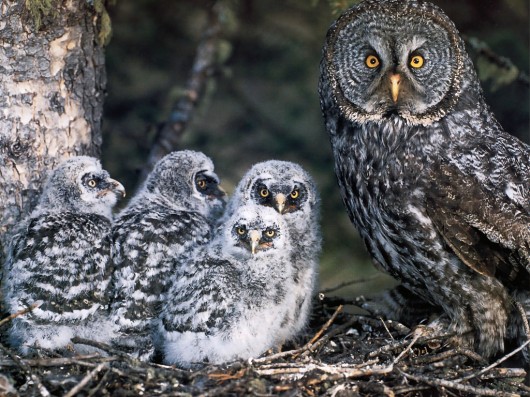 The Great Grey Owl of Lapland (Strix nebulosa) – the largest owl in existence
(click to enlarge) The Great Grey Owl of Lapland (Strix nebulosa) – the largest owl in existence
(click to enlarge)
.
‘A little knowledge is a dangerous thing‘ is a wise old proverb meaning that a small amount of knowledge can mislead people into thinking that they are more expert than they really are.
The phrase is considered originally derived from English politician and philosopher, Francis Bacon, in his literary work ‘The Essays: Of Atheism‘ of 1601, as follows:
.
“A little philosophy inclineth man’s mind to atheism; but depth in philosophy bringeth men’s minds about to religion.” [1]
.
It may generally apply quite aptly across the human species. Homo sapiens sapiens is the most intelligent species on the planet. Yet given our legacy thus far, are we really much more intelligent than any other species that exists simply to breed and perpetuate its species?
Our intelligence has enabled us to successfully breed not just for survival, but to colonise the planet like no other. Yet our intelligence can only be a little more intelligent than other species, since our breeding and colonisation has grown to such an extent that it has driven other species to extinction and has destroyed much of the planet upon which we depend. While other species have a symbiotic relationship with their environment, the extent of ecological destruction that humanity has caused and continues to cause to our host planet makes us Earth’s Pathogen. A pathogen is an agent causing disease or illness to its host, such as an organism or infectious particle capable of producing a disease in another organism. Human breeding and colonisation is extreme to the extent that it is approaching 7 billion. As we exponentially breed, colonise and destroy, we destroy our host planet.
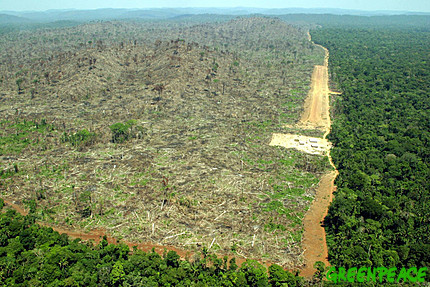
Speaking of religion, the demise and extinction of the Rapa Nui civilization on the remote Easter Island in the Pacific Ocean has become a metaphor for the self-destruction of humanity. One theory for the collapse of the Rapa Nui culture is that the Ancestor Cult that respected the dead drove the building of large stone statues (moai) to represent deified ancestors. It was believed that the living had a symbiotic relationship with the dead where the dead provided everything that the living needed (health, fertility of land and animals, fortune etc.) and the living through offerings provided the dead with a better place in the spirit world. The island’s trees were killed and used to help move these massive moai into desired position, but over time, as more moai were erected, the island’s trees were eliminated. Absolute deforestation led to the collapse of the island’s ecosystem and food supply and so to the demise of the Rapa Nui.
A second theory is that by Hunt and Lipo (2006) who found no evidence of human deforestation, or of human habitation prior to 1200. Instead, they suggest that the collapse of island society was due to the introduction of Polynesian Rats that arrived in the boats of early settlers. They hypothesize that rat population spiked at around 20 million individuals, and that these rats quickly consumed all the seeds of the native palms, leading to the collapse of the island food supply. [2]
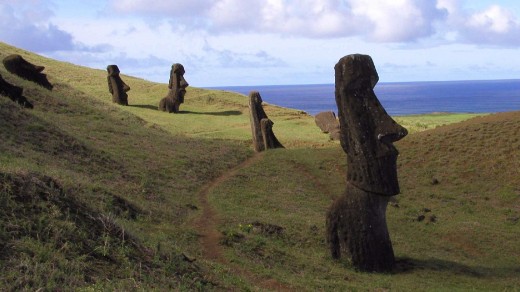 The Moai of Easter Island,
the living faces of worshipped ancestors of the Rapa Nui people
(click to enlarge) The Moai of Easter Island,
the living faces of worshipped ancestors of the Rapa Nui people
(click to enlarge)
.
.
‘Homo sapiens – time for a new name?
The following article is directly sourced from a transcript by Julian Cribb on the ABC Radio Science Show programme, which was aired 20110820 [3]
.
“It is high time the human race had a new name. The old one, Homo sapiens – wise or thinking man – has been around since 1758, and is no longer a fitting description for the creature we have become. When the Swedish father of taxonomy, Carl Linnaeus, first bestowed iti, humans no doubt seemed wise when compared with what scientists of the day knew about both people and other animals. We have since learned our behaviour is not quite as intelligent as we like to imagine, while some other animals are rather smart. In short, ours is a name which is both inaccurate and which promotes a dangerous self-delusion.
In a letter to Nature I am proposing there should be a worldwide discussion about the formal reclassification of humanity, involving both scientists and the public. The new name should reflect more truthfully the attributes and characteristics of the modern 21st century human, which are markedly different from those of 18th century ‘man’.
Consider the following: Humans are presently engaged in the greatest act of extermination of other species by a single species, probably since life on Earth began. We are destroying an estimated 30,000 species a year, a scale comparable to the greatest extinction catastrophes of the geological past.ii We currently contaminate the atmosphere with 30 billion tonnes of carbon equivalent every year.iii This risks an episode of accelerated planetary warming reaching 4-5 degrees by the end of this century and 8 degrees thereafter, a level which would severely disrupt food production.iv Estimates for the ultimate losses from 8of warming range from 50 to 90% of humanity.v
We have manufactured around 83,000 synthetic chemicalsvi, many of them toxic at some level, and some of which we inhale, ingest in food or water or absorb through the skin every day of our lives. A US study found newborn babies in that country are typically contaminated by around 200 industrial chemicals, including pesticides, dioxins and flame retardants.vii These chemicals are now found all over the planet, and we are adding hundreds of new ones, of unknown risk, every year. Yet we wonder why more people now die of cancer.
Every year we also release around 121 million tonnes of nitrogen, 10 million tonnes of phosphorus and 10 billion tonnes of CO2 into our rivers, lakes and oceans, many times the amounts recirculated by the Earth naturally. This is causing the collapse of marine and aquatic ecosystems, disrupting food chains and causing ‘dead zones’. More than 400 of these lifeless areas have been discovered in recent times.viii
We are presently losing about 1% of the world’s farming and grazing land every year. This has worsened steadily in the last 30 years, confronting us with the challenge of doubling food production in coming decades off a small fraction of today’s area. At the same time we waste a third of the world’s food.ix
Current freshwater demand from agriculture, cities and energy use will more than double by mid century, while resources in most countries – especially of groundwater – are drying up or becoming so polluted they are unusable.x
We passed peak fish in 2004xi, peak oil in 2006xii, and will encounter growing scarcities of other primary resources, including mineral nutrients, in coming decades. Yet demand for all resources, including food, minerals, energy and water, will more than double, especially in Asia.
Humanity spends $1.6 trillion a year on new weaponsxiii, but only $50 billion a year on better ways to produce food. Despite progress in arms reduction, the world still has around 20,000 nuclear warheads and at least 19 countries now have access to them or to the technology to make them.xiv
Finally, we are in the process of destroying a great many things which are real – soil, water, energy, resources, other species, our health – for the sake of a commodity that mostly exists in our imagination: money. While money has its uses as a medium for exchange, humanity is increasingly engaged in mass self-delusion as to what constitutes real wealth, as is quite clear from the current financial crisis.
All of these things carry the risk of catastrophic change to the Earth’s systems, making it difficult to justify our official sub-species name of Homo sapiens sapiens, or wise wise man. This not only looks like conceit, but sends a dangerous signal about our ability to manage what we have unleashed. A creature unable to control its own demands cannot be said to merit the descriptor ‘wise’. A creature which takes little account of the growing risks it runs through its behaviour can hardly be rated ‘thoughtful’.
The provisions of the International Code on Zoological Nomenclature provide for the re-naming of species in cases where scientific understanding of the species changes, or where it is necessary to correct an earlier error. I argue that both those situations now apply.
This is not just an issue for science; it concerns everybody. There needs to be worldwide public discussion about what is an appropriate name for our species, in the light of our present behaviour and attributes. Here are some names suggested by eminent Australian scientists. Marine scientist and author, Charlie Veron, suggests Homo finalis. Desert ecologist, Mark Stafford-Smith, proposes Homo quondam et futures – the once and future human. Spatial ecologist, Hugh Possingham, likes Homo nesciens – ignorant man. And atmospheric scientist, Barrie Pittock, suggests Homo sui deludens – self-deluding man.
Down the track we should not rule out an eventual return to the name Homo sapiens, provided we can demonstrate that we have earned it – and it is not mere flatulence, conceit or self-delusion. The wisdom to understand our real impact on the Earth and all life is the one we most need at this point in our history, in order to limit it. Now is the time humans get to earn, or lose forever, the title sapiens.”
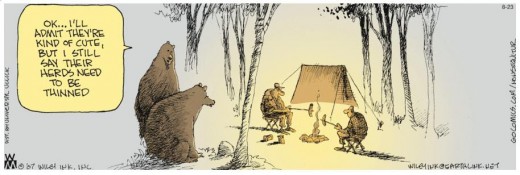 (Source: Non Sequitur – by Wiley Miller, ^http://www.gocomics.com/nonsequitur/2011/08/23) (Source: Non Sequitur – by Wiley Miller, ^http://www.gocomics.com/nonsequitur/2011/08/23)
.
.
Editor: Globally, a material difference between Humanity and other species is that we are more intelligent at doing what other species naturally do – colonising for our own self-interest. We are Homo colonus ventosa (the conceited coloniser), or simply Homo ego ruina (self-destructive Man).
If we accept that at our current stage of evolution we have a little more knowledge than other species; and that our legacy has proven thus far to be dangerous to us, other species and to the planet, then we would be wise to seek deeper knowledge of our circumstance, of our place and of other species and the planet. The test for Humanity now is to ask what would the wise do and not do? A first step in advancing our species is to recognise that we have become Earth’s Pathogen. the second step is to recognise that we don’t know the true extent of the damage we are causing to the planet and so in the face of such uncertainty, we are wise to adopt a precautionary approach. The Precautionary Principle states: ‘When an activity raises threats of harm to human health or the environment, precautionary measures should be taken even if some cause and effect relationships are not fully established scientifically. In this context the proponent of an activity, rather than the public, should bear the burden of proof. The process of applying the Precautionary Principle must be open, informed and democratic and must include potentially affected parties. It must also involve an examination of the full range of alternatives, including no action.’ [4]
.
‘We abuse land because we regard it as a commodity belonging to us. When we see land as a community to which we belong, we may begin to use it with love and respect.’
~Aldo Leopold, A Sand County Almanac (1949).
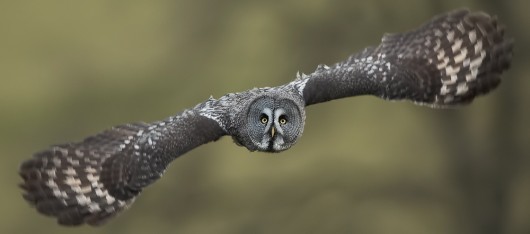 The Great Grey Owl in flight
(click to enlarge) The Great Grey Owl in flight
(click to enlarge)
.
.
References:
.
[1] ^ http://www.phrases.org.uk/meanings/a-little-knowledge-is-a-dangerous-thing.html
[2] Hunt, T. L.; Lipo, CP (2006). “Late Colonization of Easter Island”. Science 311 (5767): 1603
[3] ‘ Homo sapiens – time for a new name?‘, Julian Cribb, ^ http://www.abc.net.au/rn/scienceshow/stories/2011/3294576.htm, accessed 20110825
[4] Nancy Myers, 2004, ‘The Rise of the Precautionary Principle – A Social Movement Gathers Strength’ in  , September 2004, Vol. 25, No.9, http://multinationalmonitor.org/mm2004/09012004/september04corp1.html [> Read More]
.
– end of article –
Tags: a little knowledge is a dangerous thing, Aldo Leopold, Earth's Pathogen, Easter Island metaphor, Great Grey Owl, Homo sapiens sapiens, human pathogen, Rapa Nui
Posted in Owls, Ph05 Earth's Pathogen, Threats from Deforestation, Threats from Overpopulation | No Comments »
Add this post to Del.icio.us - Digg
Friday, August 19th, 2011
(The following article was initially posted on CanDoBetter.net by Tigerquoll on 20090426. It has since been modified.)
.
 VicForests’ neo-colonial practice of logging old growth East Gippsland forests, justifies such culling by claiming compliance with Australia’s wood production Standard AS 4708-2007. But this standard is Mein Kampf for ecological genocide of East Gippsland Forests. VicForests’ neo-colonial practice of logging old growth East Gippsland forests, justifies such culling by claiming compliance with Australia’s wood production Standard AS 4708-2007. But this standard is Mein Kampf for ecological genocide of East Gippsland Forests.
Have a read: http://www.forestrystandard.org.au/files/Standards/4708.pdf [Read the Standard]
Under this official Australian Standard that sees only the wood for the trees, it includes two criteria that serve to deliver propaganda spin respect for forest ecology. One must recognise these criteria accompanying Criterion 4—Forest management shall maintain the productive capacity of forests. Need I say more?
Forestry Propaganda Criterion #3 for instance, requires forest management to ‘protect and maintain the biological diversity of forests’. Wonderful wholesome, noble and holistic rumblings about this one – but gullibles wake! VicForests <em>Mein Kampf</em> hides the ‘ chainsaw-speak‘ in the detail:
* ‘Small-scale clearing is permitted up to a limit of 40 hectares on a single forest management unit’. ‘Conservation of threatened (including vulnerable, rare or endangered) species and ecological communities requires the forest manager to minimise adverse impacts by ensuring he/she takes into account of known information and relevant specialist advice‘. (Makes Fiji look like a democracy!)
Forestry Propaganda Criterion 5 requires forest management to maintain forest ecosystem health and vitality, yet is so vague as to allow forest ‘practices’ only to ensure that damage stays “within tolerable levels”. Does this mean one tree per hectare can be left standing or may be two?
.
Then there’s Clause 4.5.3:
‘Forest managers managing native forests shall use fire and other disturbance regimes to maintain and enhance forest ecosystem health where appropriate to the forest type or scale.’ [p.25]
.
…that is, burn and disturb native forests at will, because we argue that doing so enhances forest ecosystem health. Whoops! The wind picked up and the forest is gone; still we complied with AS 4708-2007!
Such contemptible logic would argue that a bushfire raging through a town can to it good, because eventually the town is rebuilt and the people eventually return, look at Narbethong!
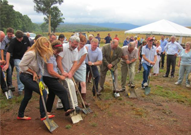
.
.
The Ferguson Tree – lest we forget
.
“The tallest tree ever properly measured was a Eucalyptus tree and was 436 feet tall. It was measured by William Ferguson on the 21st of February in 1872. Alarmingly the crown was broken off when the tree was still 1 meter thick, leading to claims that it once was up to five-hundred feet tall in one point in its lifetime.”
The length was a staggering (if true) 133 metres (436 feet) with its crown (the tree’s top) broken off!! The stump’s diameter five feet off the ground was 5.5m (18 feet) and at its broken top its diameter was still 1 metre. It is estimated that had this tree actually still been intact it would have approached 152m (500 feet) in height. The surveyor also noted numerous fallen trees in the same area over 106m (350feet) in height.
It would have been a Mountain Ash or Eucalyptus regnans. Sorry, no photo available. The legend remains only in text.
[Source: ^http://jtpredwoods12345.blogspot.com/]
.
.
‘VicForests accused of felling old-growth mountain ash’
.
[Source: Adam Morton, 20100629, The Age newspaper, ^http://www.theage.com.au/victoria/vicforests-accused-of-felling-oldgrowth-mountain-ash-20100628-zf5o.html]
.
‘The Victorian government’s forestry arm will face a legal challenge over claims it illegally logged old-growth forest and increased the risk to a threatened species.
Environmental groups accuse VicForests of felling dozens of pre-1900 ash eucalypts, breaching the Central Highlands Forest Management Plan. An impending legal case will also claim the timber agency failed to protect habitats necessary for the survival of Victoria’s threatened faunal emblem, Leadbeater’s possum.
Ecologist Jacques Cop, from consultants Acacia Environmental Group, said a survey of just one coupe near Toolangi found 31 pre-1900 ash eucalypts had been logged. Five stumps were more three metres across.
”These are trees that are 200 or 300 years old,” he said.
Mr Cop said the area should also have been protected as a Leadbeater’s possum habitat as it met the threshold of having at least 12 hollowed trees within three hectares. He said neither the state Department of Sustainability and Environment nor VicForests carried out ground surveys to check if ecological requirements were being met. Sarah Rees, president of local group My Environment, said the situation was an emergency.
’31 pre-1900 ash eucalypts had been logged’
.
“If this doesn’t stop we’re going to lose the last viable habitat for a range of different species, but Leadbeater’s possum carries the strongest case for legal protection“, she said.
The state government said it took the allegations “extremely seriously“.
Spokesman Michael Sinclair said VicForests would investigate the alleged breaches and report to the Department of Sustainability and Environment. VicForests spokesman David Walsh said the agency carried out detail planning before harvesting to ensure it acted within the law and had offered to meet local residents to better understand their concerns.
“No old-growth forest is harvested by VicForests in Victoria’s central highlands region”, he said.
The legal case, being prepared on behalf of a group called the Flora and Fauna Research Collective, comes amid community concern about the scale of logging in the central highlands after the Black Saturday bushfires.
The Wilderness Society said that evidence supporting the latest claims showed illegal logging of native forests was rife under the state government’s watch.
A separate allegation of illegal logging at Brown Mountain, in east Gippsland, is the subject of a pending Supreme Court judgment.
“Premier Brumby must act now to end VicForests’ woodchip rampage in Victoria’s magnificent native forests“, said Wilderness Society spokesman Luke Chamberlain.

Sarah Rees at the base of an ancient mountain ash spared the chainsaw but killed during a clean-up fire near Toolangi.
She says the present situation is an emergency.
Photo: John Woudstra
.
.
 VicForests motto reads: “Victorian Timber: beautiful, natural, functional” VicForests motto reads: “Victorian Timber: beautiful, natural, functional”
[SOURCE: http://www.vicforests.com.au/]
.
..in lay terms, this means kill beautiful natural specimens – they make the finest woodchips for reliable REFLEX office paper.
.
.
VICFORESTS: “VicForests employs over 140 staff across 10 Victorian sites located in Melbourne, Healesville and regional areas of Central Highlands and East Gippsland.
We have a variety of exciting career opportunities available – our Foresters specialise in tactical and operational planning, roading, harvesting and contract management, silviculture and native forest regeneration.
Other career paths include customer management, resource and business analysts, safety and risk, operational audit, forest scientists and product delivery.”
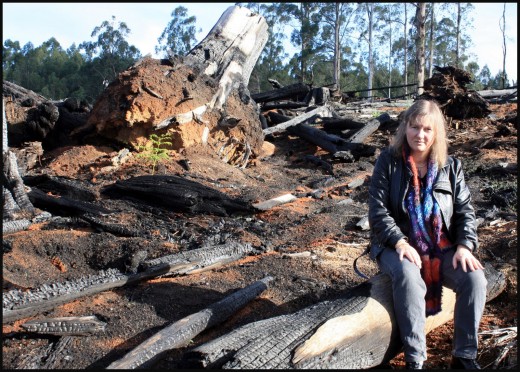
VICFORESTS: “We also employ staff in non-forestry roles including IT, HR, communications, finance, administration and customer service. A significant proportion of our staff and contractors are also involved with fire-fighting efforts each year.
VicForests is focused on investing in its employees through training, development, and providing career opportunities.”

VICFORESTS: “We look for dynamic people who have a strong desire to be part of an organisation that strives to achieve success through implementing excellent and innovative business and timber industry practices for our customers and stakeholders.
Contributing to the timber industry is something that VicForests and its staff are proud of.”
.
[Source: ^http://vicforests.logic1.com.au/employment.htm, accessed 20110819]
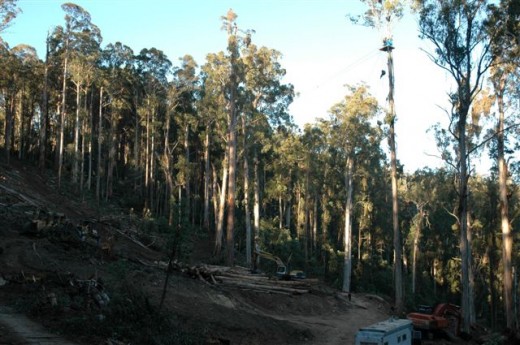 Vicforests’ coup at Stoney Creek
East Gippsland 2009 Vicforests’ coup at Stoney Creek
East Gippsland 2009
.
.
‘VicForests’ 2009 Annual Report reveals $5.1 million loss’
.
‘VicForests’ 2009 Annual Report has once again revealed that the logging agency continues to waste taxpayer millions of dollars sending our forests to the woodchip mills. The report shows that VicForests has posted a loss this year of $5.1 million. This is on top of last year posting a tiny profit after receiving a $5 million lifeline from government, and a loss the previous year.
 Woodchip train makes its way to Midways, Geelong (2009) for as little as $2.50 per tonne.
Photo: Wilderness Society Collection
Woodchip train makes its way to Midways, Geelong (2009) for as little as $2.50 per tonne.
Photo: Wilderness Society Collection
.
‘Whilst VicForests squanders Victorian taxpayer’s hard earned money, woodchipping and paper companies continue to post handsome profits. Whilst we don’t yet know how much they will make for 2009, South East Fibre Exports, a wholly owned subsidiary of Japanese paper giant, Nippon Paper, last year made over $10 million profit. They woodchipped approximately half a million tonnes of Victoria’s native forests, and this year paid as little as $2.50 per tonne for them.
Another giant company, Australian Paper, which makes Reflex papers, is VicForests’ largest single customer and was recently purchased for around $700 million by Nippon Paper. The $5.1 million loss is on top of an extra $1.3 million handout for bushfire recovery and does not include the massive $29 million royalty that it has failed to hand over to the state government who, along with the Victorian public, own these forests.’
.
[Source: ^http://www.wilderness.org.au/campaigns/forests/vicforests-2009-annual-report-reveals-5.1-million-loss]
 A tombstone of the once impenetrable forest.
A Mountain Ash stump alongside an old forestry track in Balnook, Gippsland.
Note the notches cut in the trunk for standing planks to cut the tree down by axe!
A tombstone of the once impenetrable forest.
A Mountain Ash stump alongside an old forestry track in Balnook, Gippsland.
Note the notches cut in the trunk for standing planks to cut the tree down by axe!
.
.
Reflex Office Paper
‘Paperlinx’s giant Maryvale mill located in Victoria’s Central Highlands is the largest pulp and paper making complex in Australia, consuming 475,000 cubic metres of eucalyptus forest per annum (RFA, 1998).
‘In July 2006, the Maryvale Mill received Forest Stewardship Council (FSC) Chain of Custody Certification for A4 Reflex products manufactured on its Number 3 and Number 5 Paper Machines. Paperlinx has been proudly promoting its environmental credentials ever since (as well as before).
Paperlinx is Australia’s only office paper producer. Its flagship product REFLEX copypaper is 100 per cent virgin native forest. Woodchips to make the paper are sourced from areas including rainforest, old growth forest, endangered species habitat and Melbourne’s largest water source, the Thompson Dam catchment area. Woodchips are also sourced from the Strzelecki Rainforest Reserve, an area that was promised protection by the state government due to its high conservation value.
These areas can be visited and viewed first hand, or determined by satelite image maps which show different forest types (such as rainforest as compared to woodlands) and where logging is occuring. The fact that Paperlinx gained FSC accreditation has raised concerns amoung environment groups who have been campaigning for the protection of these areas for over a decade.
Reflex Recycled Paper
Paperlinx has recently released a brand of paper wrapped in green packaging labelled Recycled. Fifty percent of REFLEX Recycled paper is made from pre-consumer waste (printers’ offcuts), but no genuine post-consumer (eg kerbside collected) recycled papers. The other fifty percent is from the same virgin native forest as stated above.
According to The Wilderness Society Paperlinx has the resources and technology to make use of alternative sources such as plantations and recycled paper, but doesn’t do so as it receives state-owned native forest logs for a significantly lower cost than plantation logs.
Due to the lack of accurate information reaching the public, an alliance of Australia’s peak environment groups including The Wilderness Society, Environment Victoria, Friends of the Earth and the Australian Conservation Foundation released a flier in 2004 urging people to boycott REFLEX paper and listing alternatives.
THE ALTERNATIVE
There is no 100 per cent recycled office paper manufactured in Australia. Brands made overseas that are available in Australia include Evolve, Canon 100 and Fuji Xerox Recycled Supreme.’
[Source: ‘Reflex Office Paper‘, Greenwash .org ^http://www.greenwashreport.org/node/41 ]
.
‘Always rely on Reflex to woodchip old growth‘
  Scott Gentle from the Victorian Forest Contractors Association
questions the logic of the Yarra Ranges council’s decision to boycott Reflex paper products.
[Source: ^http://free-press-leader.whereilive.com.au/news/story/paper-ban-anger/] Scott Gentle from the Victorian Forest Contractors Association
questions the logic of the Yarra Ranges council’s decision to boycott Reflex paper products.
[Source: ^http://free-press-leader.whereilive.com.au/news/story/paper-ban-anger/]
.
.
Further Reading:
.
[1] ‘Brown Mountain Rape’, ^http://candobetter.net/node/1005
[2] Ethical Paper, ^http://www.ethicalpaper.com.au/
[3] Save Sylvia Creek Toolangi, ^http://www.myenvironment.net.au/index.php/me/Community/SAVE-Sylvia-Creek-Toolangi
[4] Brown Mountain – final court orders, ^http://www.eastgippsland.net.au/?q=campaigns/brown_mountain/whats_new
[5] Reflex Office Paper, ^http://www.greenwashreport.org/node/41
[6] Victorian Supreme Court Decision: ‘Environment East Gippsland Inc v VicForests [2010] VSC 335 (11 August 2010)’, ^http://www.austlii.edu.au/au/cases/vic/VSC/2010/335.html
.
.
– end of article –
Tags: Acacia Environmental Group, Australian Paper, Brown Mountain, chainsaw-speak, East Gippsland logging, ecological genocide, Ferguson Tree, Forestry Standard 4708, Forestry Standard Certification, Gippsland Giants, illegal logging, Leadbeater’s possum, Logging, Nippon Paper Group, Reflex Paper, Toolangi, VicForests
Posted in Gippsland (AU), Possums and Gliders, Threats from Deforestation | No Comments »
Add this post to Del.icio.us - Digg
Thursday, August 18th, 2011
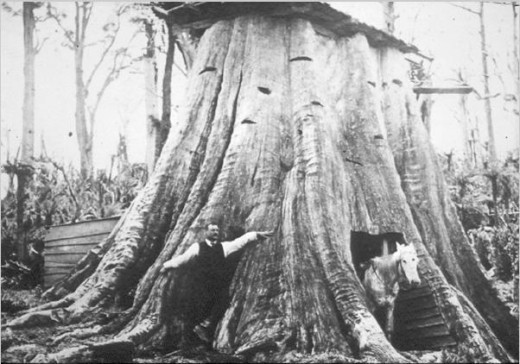
Gippsland Giants
by John Stephens
.
‘Do you know that possibly the biggest living thing in the world once lived in Gippsland and that its descendents still live here? No it’s not the blue whale, nor the giant kangaroo or the thylacine or even the black panther, it’s Eycalyptus regnans, the Victorian or Mountain Ash! These trees are the world’s tallest hardwoods and the tallest flowering plants.
The trees in the Tara Bulga Park are certainly imposing and of an impressive size, somewhere in the vicinity of sixty metres tall! You’ve seen Mountain Ash on drives or walks throughout the Strzelecki Ranges or the Baw Baw plateau. But I’m sorry to tell you, that you haven’t seen a real Mountain Ash and are most unlikely to ever see one. Of course I am talking about specimens that did exist before we “harvested” them. I don’t consider myself a “greenie” however I cannot be anything but amazed at the destructiveness of the human species.
During my “younger days” I spent many an enjoyable hour riding a motorcycle around the top end of Merriman and Traralgon Creeks. One of my greatest memories was seeing the stumps of some huge trees that had been logged, somewhere on the western side of the Merriman Creek headwaters, and imagining what they must have looked like in their original grandeur. I also came across the huge “historic” tree stumps at Mt Tassie and as many others have, I marvelled at their massive girth.
The Ada Tree near Powelltown, which is estimated to have existed for over three hundred years, is possibly the largest remaining specimen in Victoria. It has been preserved and is estimated to stand at about 76 metres, although it was significantly taller. The crown has been blown away either in a storm or struck by lightning, meaning the tree may have reached a height in the vicinity of 120 metres. Another giant, The Big Tree, in the Cumberland Tall Trees Reserve is 82 metres tall, but was 92 metres before a storm destroyed the top in 1959. What stuns me, is that if I imagine one of these trees to be the imposing Eucalyptus obliqua in the top corner of my block and it fell along the fence line, it would stretch the full 83 metres of the block!
“The Baron” height – 66m, girth 14.5m
 |
Near Narbethong – 91m, girth 7.7m
 |
I understand that to our pioneers the supply of forest, trees and timber seemed endless and they had a need to provide land for agriculture and development. However I do not understand their need to destroy everything that they saw as a challenge. Why did they have to destroy the Centennial Exhibition Tree that had stood in the Menzies Creek forest for hundreds of years until its demise in 1888? It was measured at over 122 metres after being felled and was reassembled for display at the exhibition in Melbourne. Surely it would have been better to take parties to visit the living tree in its natural surrounds and glory.
Part of an article written by Paul Edwards cleverly conveys what most of us feel about these giants – “When a tree gets old and tumbles, it becomes a noble thing — a fallen tree — but when it is cut down it turns into a log”. The best way to measure a tree is of course to do so when it has been cut down. This is essentially what happened to another giant at Thorpdale. It was felled in the1880s, measured by the surveyor G Cornthwaite, and found to have been 114.3 metres tall. I believe all that remains to signify the existence of this giant is a sign on the roadside indicating where it once stood, definitely far less impressive than the tree itself.
Some of these old trees must have been even more impressive. A 66 metre tall tree in Sassafras Gully in the Dandenongs and known as “The Baron” had a girth of 14.5 metres. The Bulga Stump, which was destroyed in the 1939 bushfires, famous for its huge girth of 34 metres! The Furmstons or Mueller Tree near Mt Monda was only 60 metres high when it fell in 1998 although it was estimated to be well over 100 metres when it was first discovered in the late nineteenth century. Another giant was a hollow stump in the Tarra Bulga area that had a roof and was used as a stable. The hollow Wonga Stump near Yarram was used as a church and a school until it was destroyed by fire in 1898.
The tallest known existing tree in the world is now a Californian Redwood (Sequoia semprivirens) found in the Humbolt Redwood State Park. It is 112.7 metres in height but is “small” compared to the tallest ever recorded, an American Douglas fir (Pseudotsuga menziesii) which was known to be 122 metres, equal to our Centennial Tree. However do these trees really compare to our own? A tree at Mt Baw Baw measured in 1889 by surveyor G W Robinson was reported to be 143 metres in height.
In 1872 the Victorian Government surveyor, William Ferguson, reported finding a fallen tree in the Healesville area that was 133 metres long. The top had been broken off in the fall and most of the crown burnt in a fire. Where it was broken the tree was approximately one metre in diameter and was estimated therefore to have been 152 metres tall!
Were there bigger specimens or are there still giants in the Gippsland forests? Maybe there was a tree of such dimensions that if in my imagination it fell the length of my block it would also complete the side boundary of the property behind mine.
[Source: ^ http://home.vicnet.net.au/~apslvg/gippslandGiants.html]
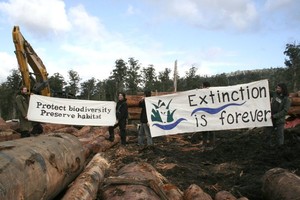
Title of this article is derived from two well known sayings:
- ‘Forgive them, for they know not what they do.’ Source: The Bible: ‘And Jesus said, “Father, forgive them, for they know not what they do.” And they cast lots to divide his garments.’
[© English Standard Version, Luke (23:34) 2001)]. These are supposedly Jesus’ words from the cross, asking forgiveness for those who put him to death. More widely, of course, the plea was for all humanity. [Rare historic photos of these magnificent trees are all that allow us to remember what once was. The saying is quite apt to old-growth trees, though I have removed the ‘Father, forgive them‘ clause.]
- ‘Lest we forget‘ Source: Rudyard Kipling’s poem of 1897, ‘Recessional’, which he composed on the occasion of Queen Victoria’s Diamond Jubilee in 1897. The poem, on the one hand, expresses pride in the British Empire, but, on the other, expresses an underlying sadness that the Empire might go the way of all previous empires. [Again, quite apt to old-growth trees.]
.
‘God of our fathers, known of old—
Lord of our far-flung battle line—
Beneath whose awful hand we hold
Dominion over palm and pine—
Lord God of Hosts, be with us yet,
Lest we forget—lest we forget!
The tumult and the shouting dies—
The Captains and the Kings depart—
Still stands Thine ancient sacrifice,
An humble and a contrite heart.
Lord God of Hosts, be with us yet,
Lest we forget—lest we forget!
Far-called our navies melt away—
On dune and headland sinks the fire—
Lo, all our pomp of yesterday
Is one with Nineveh and Tyre!
Judge of the Nations, spare us yet,
Lest we forget—lest we forget!
If, drunk with sight of power, we loose
Wild tongues that have not Thee in awe—
Such boastings as the Gentiles use,
Or lesser breeds without the Law—
Lord God of Hosts, be with us yet,
Lest we forget—lest we forget!
For heathen heart that puts her trust
In reeking tube and iron shard—
All valiant dust that builds on dust,
And guarding calls not Thee to guard.
For frantic boast and foolish word,
Thy Mercy on Thy People, Lord!
Amen.
.
– end of article –
Tags: Centennial Exhibition Tree, Dandenongs, Eucalyptus regnans, Gippsland, Gippsland Giants, Logging, Menzies Creek, Mountain Ash, Mt Baw Baw, Mueller Tree, old growth, The Baron, The Big Tree, The Bulga Stump, Thorpdale, world's largest trees
Posted in Gippsland (AU), Threats from Deforestation | No Comments »
Add this post to Del.icio.us - Digg
Wednesday, August 17th, 2011
The following article was initially published by The Wilderness Society (NSW) on its website 20110809. Reproduced with permission from The Wilderness Society (NSW):
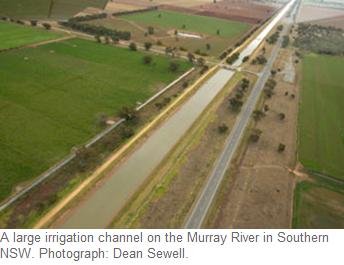
.
Economists say water buybacks can save the Murray-Darling River
A senior economist at The Australian National University (ANU) says that subsidising water infrastructure will not deliver the volumes of water needed to return the Murray-Darling River system to health.
Professor Quentin Grafton from the Crawford School of Economics and Government at the ANU says that despite the Australian Government making commitments to spending $5.8 billion on infrastructure designed to increase water efficiency, this will have little impact on increasing flows through the ailing system.
“That’s probably going to get the government about 500 gigalitres. So to put that in perspective, that’s a fraction of the sorts of numbers we need in terms of volumes for the rivers“, said Prof. Grafton.
“By contrast, if we were to purchase water entitlements from willing sellers, we can get the volumes that we need”.
.
Water Buyback a Sound Approach
.
The Productivity Commission has supported this view, calling for some of the money allocated to infrastructure to be redirected to other initiatives, including water buybacks from willing sellers and support for affected communities.
“A general conclusion is that purchasing water from willing sellers is a sound approach to meeting the Australian Government’s commitment to obtain additional water for the environment. Indeed, it should be the preferred method for recovering water, taking precedence over subsidising investment in water saving infrastructure“, concluded the Commission.
While big irrigation companies continue their scare campaign saying that water buybacks will have a negative economic impact on the agricultural industry, a model proposed by Prof. Grafton concluded that irrigators would be adequately compensated.
“If the $8.9 billion currently budgeted for water reform were spent in a cost effective manner on the purchase of water entitlements rights from willing sellers, and with no arbitrary restrictions on water trade, the Australian government would be able to increase environmental flows by at least 4,000 gigalitres per year, fully compensate irrigators for reduced extractions, and have funds left over.”
This is a much better alternative than committing massive financial resources to infrastructure that will not save the Murray-Darling River.
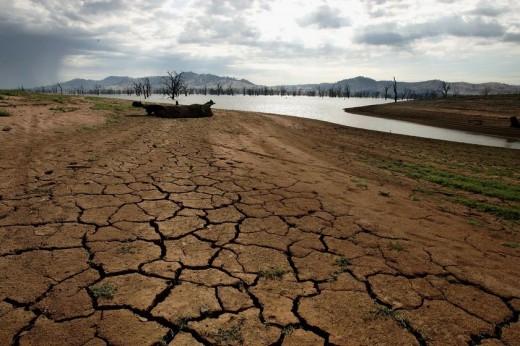 ^http://annamariacom.blogspot.com/2010/10/murray-darling-basin.html ^http://annamariacom.blogspot.com/2010/10/murray-darling-basin.html
.
More Willing Sellers than Tenders
.
Far from being unpopular with many farmers, recent tenders for water buybacks have been oversubscribed, with the majority of sellers only parting with a portion of their entitlements and using the capital raised to improve efficiency or diversify their businesses.
The Australian Government needs to spend the $10 billion of taxpayers’ money allocated to save the river system wisely and ensure the rivers flow, or give the Australian people their money back.
With the health of the rivers and the communities that rely on them at stake, we need economically responsible action that ensures that the rivers keep flowing whilst building stronger, more economically diverse and sustainable rural communities.
Prof. Grafton concluded that, “Unless we spend most of the money on the buying of the water entitlements, we won’t have sufficient flows for the rivers, and that’s a critical point. Because otherwise, we’ll end up spending billions and billions of dollars, we won’t get sufficient volumes for the rivers so we’ll have the problem we’ve gone through in the last few years come back again.”
“The communities will continue to be in a trouble because they won’t get the support that they need, and we’ll end up in a few years time with lots of concrete channels but no water”.
[Source: ^ http://www.wilderness.org.au/regions/new-south-wales/water-buybacks-can-save-the-river]
 Andrew Tatnell, dying River red gums at Chowilla, South Australia in 2004
Photo by Andrew Tatnell
[Source: ^http://www.sauer-thompson.com/archives/opinion/2004/04/ironbar-cracks-again.php] Andrew Tatnell, dying River red gums at Chowilla, South Australia in 2004
Photo by Andrew Tatnell
[Source: ^http://www.sauer-thompson.com/archives/opinion/2004/04/ironbar-cracks-again.php]
.
.
Further Reading:
.
[1] ‘Modelling Water Trade in the Southern Murray-Darling Basin‘, 2004, by The Productivity Commission, ^http://www.pc.gov.au/__data/assets/pdf_file/0003/60474/watertrade.pdf
[2] Murray Darling Basin Authority, ^http://www.mdba.gov.au/basin_plan
[3] ABC Four Corners, background reading on the Murray-Darling Basin Plan, 2011, ^http://www.abc.net.au/4corners/content/2011/s3157128.htm
[4] Hawke Institute, University of South Australia, ^http://www.unisa.edu.au/hawkeinstitute/research/ecosocial/eco-case-study.asp
[5] Murray Darling Association, ^http://www.mda.asn.au/index.cfm?objectid=531DFD7D-D372-0C96-D485B3EAC56F6BF9
[6] Act Now, ^http://www.actnow.com.au/Issues/MurrayDarling_Basin.aspx
[7] Save the Murray, ^http://www.savethemurray.com/
[8] Murray Futures, ^http://www.murrayfutures.sa.gov.au/lower.php
[9] Hurry Save the Murray, ^http://hurrysavethemurray.com/
[10] Murray Darling & the Coorong, ^http://rachel-siewert.greensmps.org.au/content/speech/murray-darling-coorong [extract of speech below]
.
.
[Speech by Rachel Siewert MP, The Australian Greens,Thursday 19th June 2008, ^http://rachel-siewert.greensmps.org.au/content/speech/murray-darling-coorong]
.
“I rise to speak to the motion to take note of the response of the Minister for Climate Change and Water, Senator Wong, representing the Minister for the Environment, Heritage and the Arts, to a question relating to the Murray-Darling river system. Today we had yet another report released on the health of the Murray.
It should come as no surprise, to those of us in particular who have been watching the Murray, that it finds that only one of 23 river valleys of the Murray that were examined had good ecosystem health. Two had moderate ecosystem health. All the rest-that is 20-had poor or very poor ecosystem health. This comes on the back of the report that was released yesterday-well, it was not released; it was leak-released.
On ABC radio the CEO of the Murray-Darling Basin Commission, Wendy Craik, said that the report had not ‘not been released‘; it just had not been released. That report, which had not been released but was not leaked, showed that scientists have said to the government that the Coorong has six months left. They have a six-month window of opportunity, and what is the ministerial council’s response? ‘Oh, we’ll commission some more work into that.’ That just happens to then be available in November. The window of opportunity to fix the Coorong, or to go to some measure to try to remediate the Coorong, closes in October.
.
The report that came out today shows yet again what a parlous state our Murray-Darling river system is in. And what is the government doing about it? Yes, it is buying some water and it is investing in fixing up infrastructure, but on a very ad hoc basis. It is like fiddling while Rome burns-‘We’ll set a new cap; we’ll put in place an authority, at some stage once we get the legislation back in, that will develop a plan for two years.’ But guess what? That plan does not come into effect until 2019. And the reason for that is that the federal government refuses to require New South Wales and Victoria to bring their water sharing plans into line with the basin, into line with the sustainable cap.
That means we will have a lovely plan, we will have planned very well, while the river is dying-because, unless we can curb water use and put into place sustainable water use in the extremely near future, we are going to be watching the river die. We will have a great plan but we will have no water to put back into the river because we are not requiring the states to implement any changes to their plans until 2019. That means no action until 2019, aside from what the government might be able to buy back from willing sellers. It does not do anything about addressing, with a systematic and strategic approach, long-term land use in the Murray-Darling Basin. It does not address what we think is going to be sustainable, not only in trying to address a severely degraded system but also in the face of climate change.
.
The CSIRO reports that are gradually being released as the work is done in each catchment-excellent work, I should say-are showing, as Senator Wong correctly pointed out, that the catchments are facing very severe consequences from the impact of climate change. We have over-allocated all the systems in the Murray-Darling system and we need to be addressing that now, not leaving it for some time off in the future.
.
Some of the ways that we can start addressing the issues around the Coorong now are to start looking at releasing water from the Meningie Lakes, to start looking at accessing some of the water that is currently held in storage in northern New South Wales and to start talking to farmers about loaning water-which, I would suggest, could be repaid with some benefits to the farmers into the future. But one of the issues that I understand is complicating matters there is the control of the New South Wales government over water in the Meningie Lakes. They control the water under 460 gigalitres, and the Commonwealth then gets to have a say in anything above, I think, 660 gigalitres. Guess what? If the level is kept below 660 gigalitres, where the Commonwealth get to have a say, it is all up to New South Wales.
So New South Wales can theoretically keep allocating water from that storage to maintain a level below the amount that the Commonwealth gets to have a say in. And guess what? There is no water to release to the Murray and into the Coorong lakes. If we cannot solve this issue in the Commonwealth’s brave new world of management of the Murray-Darling Basin, there is no hope. We are absolutely in a crisis situation in the Coorong, and yet the Commonwealth is still sitting on its hands and cannot, it appears, get that water from New South Wales and actually do something to save their own icon.”
.
– end of article –
Tags: ANU, Chowilla, Coorong, ecosystem health, Meningie Lakes, Minister for Climate Change and Water, Murray-Darling, Murray-Darling Basin Commission, Productivity Commission, River Red Gums, The Wilderness Society, TWS
Posted in Murray Darling (AU), Threats from Farming | No Comments »
Add this post to Del.icio.us - Digg
Wednesday, August 17th, 2011
The following article was initially posted by Tigerquoll on 20090423 on CanDoBetter.net:
.
I have to pinch myself to realise this is 2009 and not 1959!
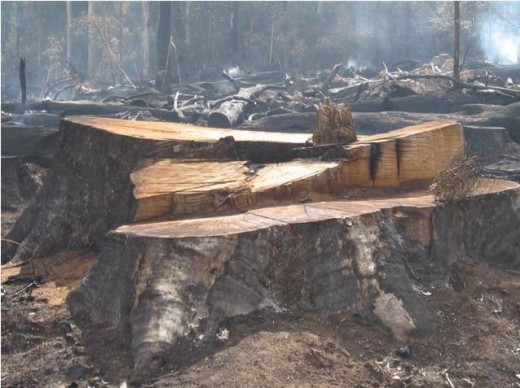 Vicforests’ logging arson to 600 year old Eucalyptus regnans in East Gippsland, Victoria, Australia, 20090423
http://www.lighterfootprints.org/2009/04/brown-mountain-destruction-complete.html Vicforests’ logging arson to 600 year old Eucalyptus regnans in East Gippsland, Victoria, Australia, 20090423
http://www.lighterfootprints.org/2009/04/brown-mountain-destruction-complete.html
This photo just in from the old growth forests of Brown Mountain in East Gippsland – home of remnant giant Australian natives dating up to 600 years old. This photo shows the Brown Mountain Massacre yesterday (23 April 2009) of these magnificent giants by VicForests on its celebrated World Forestry Day.
In 2006, the then Premier, Steve Bracks, made a promise to “protect all significant stands of old growth currently available for logging” (hollow words by a man of renouned indecision). The immense trees that have sheltered and raised hundreds of generations of owls and gliding possums are now being hacked down by VicForests.” [Source: Environment East Gippsland’s, ‘The Potoroo Review‘, Issue 196]
VicForests’ leadership inspiration, Warren Hodgson, must feel pround leaving such a legacy of heritage denial to future Gippslanders, Victorian and Australians. “Warren Hodgson has been involved in policy development at the highest level of the Victorian public sector and has previously led the Victorian Government efforts on Public Private Partnerships. He has a background in the manufacturing industry in New Zealand and in the provision of contract services to public and private sectors throughout the Asia-Pacific region.”
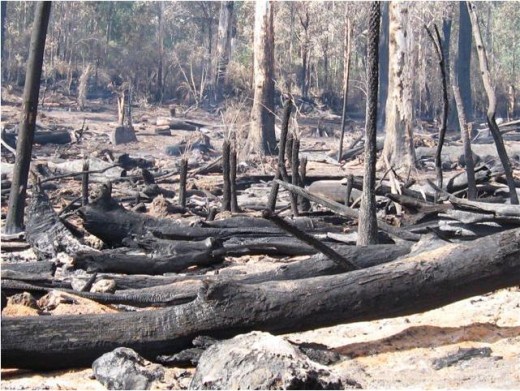
.
.
.
‘VicForests’ (from its website) presents its vision and values as:
.
Our vision:
“To be a leader in a sustainable Victorian timber industry.”
Our purpose:
“To build a responsible business that generates the best community value from the commercial management of Victoria’s State forests.”
Our values:
“Accountable – VicForests is accountable to the Victorian Government. Its actions and those of its employees must be consistent with relevant Government policy and priorities.”
Committed – “VicForests is committed to the fulfilment of its purpose and the achievement of its vision for the Victorian timber industry.”
Safe – “VicForests and its staff will manage safe workplaces for all staff and contractors, and are committed to continuous improvement in safety systems and outcomes, in accordance with its Occupational Health and Safety Policy.”
Customer focused – “VicForests will be responsive to its customers’ requirements and seek customer satisfaction, in accordance with its commercial nature.”
Ethical – “VicForests will operate in an ethical and environmentally responsible manner in all its undertakings to ensure the integrity and sustainability of the native forest timber industry in Victoria.”
Innovative – “VicForests seeks to be innovative and adaptable in its organisational, business and forestry management operations.”
Open – “VicForests will manage the commercial harvesting and sale of timber in a framework of openness and transparency.”
Professional – “VicForests and its staff will operate in a professional manner in all undertakings to ensure the best possible outcomes for the organisation, its customers, the Victorian timber industry and its stakeholders.”
Sustainable – “VicForests will pursue the highest standards for forest management practices through the continued development of its Sustainable Forest Management System and by ensuring its triple bottom line performance against the requirements of Victoria’s Sustainability Charter for State forests.”
[SOURCE: http://www.vicforests.com.au/vision-purpose-and-values.htm]
.
.
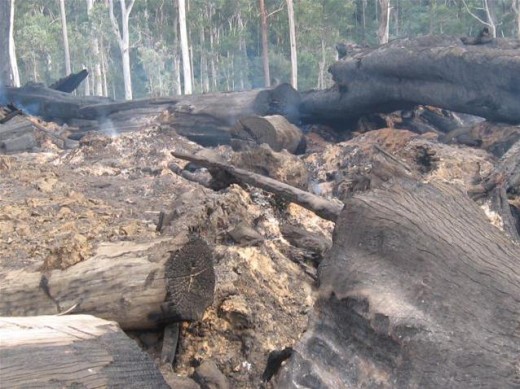
I have to pinch myself to realise this is 2009 and not 1959!
.
.
.
Brown Mountain – destruction complete!
.
An urgent message from Jill Redwood of Environment East Gippsland (from 20090424). . .
“These were taken yesterday – VicForests mission accomplished.
This ancient stand of 600(plus) year old forest has now been fully annihilated and ready for conversion to a palm-oil plantation. Or it might as well be.
They’ll actually be converted to a pulpwood plantation for the Japanese paper industry.
The other four remaining stands of old growth adjoining are on the logging schedule.
Please help in whatever way you can.”
~ Jill [Environment East Gippsland]
.
.
.
Read More:
.
[1] ^http://www.greenlivingpedia.org/Brown_Mountain_old_growth_forest
[2] ^http://www.eastgippsland.net.au/
[3] ^http://www.eastgippsland.net.au/?q=campaigns/brown_mountain
.
– end of article –
Tuesday, August 9th, 2011
 Pilliga Forest
The early morning sun illuminates fresh forest grasses
beneath a stand of young native White Cypress Pine (Callitris glaucophylla), Feb 2010
^http://huntervalleyjournal.blogspot.com/2010_02_01_archive.html Pilliga Forest
The early morning sun illuminates fresh forest grasses
beneath a stand of young native White Cypress Pine (Callitris glaucophylla), Feb 2010
^http://huntervalleyjournal.blogspot.com/2010_02_01_archive.html
.
The Pilliga Forests
.
‘The Pilliga‘, also traditionally known as ‘The Pilliga Scrub‘ is a vast western woodland – the largest continuous remnant of semi-arid woodland in temperate New South Wales, Australia. The Pilliga comprises the largest remaining area of native forest west of the Great Dividing Range, covering about 500,000 hectares between the Namoi River in the North and Warrumbungle Ranges in the South. The Pilliga is part of the Brigalow Belt South bioregion. Australian land mass is divided into 85 bioregions. Each bioregion is a large geographically distinct area of similar climate, geology, landform, vegetation and animal communities. [Read More]
The Pilliga is characterised by native white cypress and iron bark forests, broom bush plains, vivid spring flowers and abundant fauna. The forest contains at least 300 native animal species, with at least 22 endangered animal species including such favorites as the Glossy Black-Cockatoo, Squirrel Glider, Koala, Pilliga Mouse (Pseudomys pilligaensis) and Rufous Bettong, and at least 900 plant species including species now widely grown in cultivation as well as many threatened plant species. The forest spans about 3,000 square kilometres of land. Some towns that surround the forest include Narrabri, Pilliga, Gwabegar, Baradine, Coonabarabran, Boggabri and Baan Baa. Some areas of the forest, particularly in the Western Pilliga, are completely dominated by “cypress pine” (Callitris spp.), however there are a vast number of distinct plant communities in the forest, some of which do not include Callitris pine. Another dominant sub-canopy genus are the Casuarinas, while Eucalypts dominate the canopy throughout the forest. Much of the area is State Forest under the management of the New South Wales Government, which effectively means that it is unprotected.
The name ‘Pilliga’ (or ‘Billarga‘) is an Aboriginal word meaning swamp oak (Casuarina trees). The name was borrowed back in the mid 1800’s as the name of one of the original grazing runs, near where the town of Pilliga now stands. [This theory is contracted by Les Murray in his Forward in Eric Rolls‘ seminal 1981 book ‘A Million Wild Acres‘, who accounts at page iv…”the Pilliga (from Kamilaroi peelaka, a spearhead”).

The geology of the area is dominated by the Pilliga Sandstone, a coarse red/yellow Jurassic sandstone containing about 75% quartz, 15% plagioclase and 10% iron oxide,[2] although local variations in soil type do occur. Sandstone outcrops with basalt-capped ridges are common in the south, while the Pilliga outwash areas to the north and west are dominated by alluvial sediment from the sandy, flooding creeks.
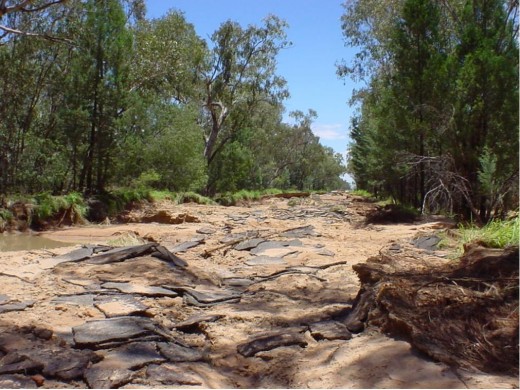 Nuable Creek in flood, Pilliga 2004
Source: David Brodrick, 2004, ^http://www.narrabriweather.net/events/10Dec2004.html Nuable Creek in flood, Pilliga 2004
Source: David Brodrick, 2004, ^http://www.narrabriweather.net/events/10Dec2004.html
.
There is a vast network of roads throughout the scrub, many of which are former forestry roads. The forest once supported a large forestry industry in the surrounding towns (harvesting mostly cypress pine and ironbarks) however this has been greatly scaled back since 2005 when much of the forest was set aside for environmental conservation by the NSW government.
[Sources: ^ http://en.wikipedia.org/wiki/Pilliga_forest, ^ http://narrabri.net/Document1.aspx?id=1872]
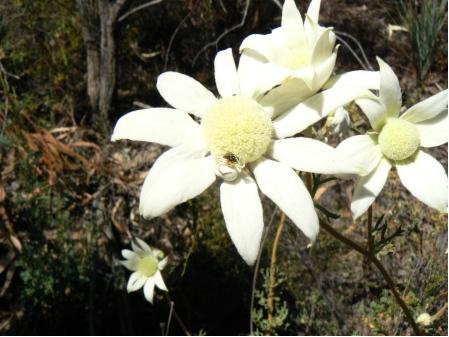
According to the Narrabri Shire Visitor Information Centre, the Pilliga Forest… ‘is one of the largest native cypress forests in Australia and hosts an abundance of wildlife including koalas, kangaroos, possums, echidnas, goannas, emus and its very own species of mouse, the Pilliga Mouse. The area is renowned for its glorious wildflowers which can be found in the Forest year round, with particularly impressive displays in Spring. The Baradine Community has developed three wildflower routes through the Forest. The “Wildflowers of Baradine and the Pilliga’.
[Source: ^ http://www.visitnarrabri.cfm.predelegation.com/index.cfm?page_id=1051&page_name=Wildflowers%20in%20the%20Pilliga]
.
.
.
‘The Pilliga’..after rain
.
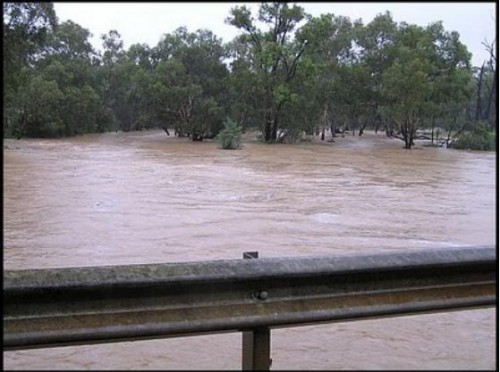
‘Prolific rain on the northwest plains of New South Wales
quickly results in a swelling of rivers and creeks,
followed by a profusion of growth and renewal.
.
Many centimetres of very welcome rain covered the black soil grazing pastures and agricultural properties
surrounding the village of Baradine over the first weekend of February, 2010.
We were there to witness this amazing natural event.
Sheets of water rapidly cover the vast plains,
draining into gullies and creeks, and filling rivers.
Many outlying unsealed roads become impassable,
and the town is temporarily isolated.
But life goes on with relative normality,
albeit with joyous appreciation of the blessings the downpour will bring.’
[Source: HunterValleyJournal, http://huntervalleyjournal.blogspot.com/2010_02_01_archive.html, Feb. 2010,]
.
.
Where is ‘The Pilliga’?
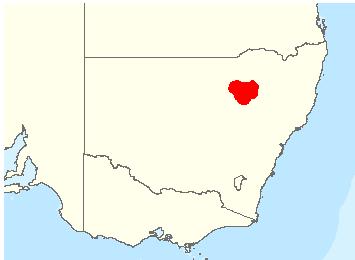 Location of ‘The Pilliga’ as shown by the distribution map of the native Pilliga Mouse
Australian Department of Environment et al.
[Source: ^http://www.environment.gov.au/cgi-bin/sprat/public/publicspecies.pl?taxon_id=99#recovery_plan_loop] Location of ‘The Pilliga’ as shown by the distribution map of the native Pilliga Mouse
Australian Department of Environment et al.
[Source: ^http://www.environment.gov.au/cgi-bin/sprat/public/publicspecies.pl?taxon_id=99#recovery_plan_loop]
.
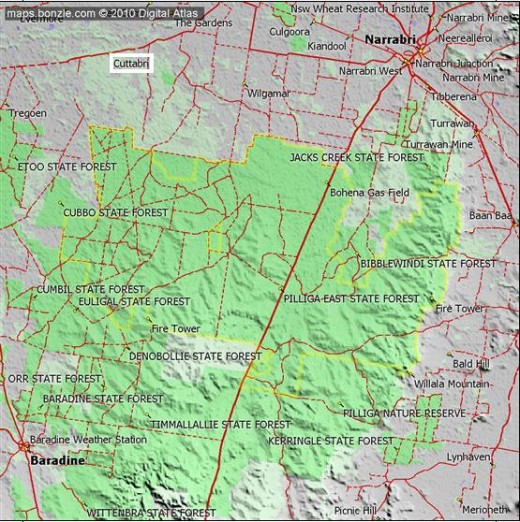 The Pilliga Forests
lie between the towns of Coonabrabran in the south and Narrabri in the north
situated in north western New South Wales in the Brigalow Belt South bioregion.
[Source: ^http://maps.bonzle.com/c/a?a=p&p=56925&cmd=sp] The Pilliga Forests
lie between the towns of Coonabrabran in the south and Narrabri in the north
situated in north western New South Wales in the Brigalow Belt South bioregion.
[Source: ^http://maps.bonzle.com/c/a?a=p&p=56925&cmd=sp]
.
.
The Pilliga’s history of colonial exploitation
.
‘Following many thousands of years of Aboriginal occupation, European settlers started arriving around the early 1830’s. These settlers established grazing runs throughout the forests, which then comprised a few well-scattered large trees over a grassy understorey. Aboriginal burning and grazing by Kangaroo Rats had kept the forest floor clear of regeneration until that time.
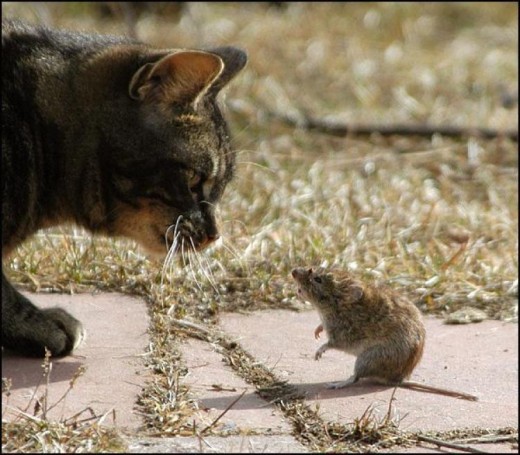
The introduction of cattle and sheep resulted in significant ecological changes. The soils deteriorated and the mix (and grazing quality) of the native grasses changed. The Kangaroo rats were displaced. The 1970’s and 1880’s produced a prolonged drought that saw most of the grazing runs abandoned. Then, during the late 1880’s and early 1890’s, there was a succession of good seasons and, in the absence of grazing pressure and regular burning; massive regeneration of native cypress and eucalyptus took place across much of the Pilliga.
The spread of rabbits to the area in the early 1900’s prevented any further regeneration events in the Pilliga until the introduction of myxomatosis in the 1950’s. With the demise of the Rabbit, a new pulse of young cypress and eucalypt seedlings was able to get up and away.
The cypress regeneration from the late 1800’s forms the basis of the timber industry operating from the Pilliga today. The 1950’s and subsequent growth is being managed to provide a sustainable supply of timber to industry for generations to come. In 1999, there were over 150 jobs dependant on the timber resources of the Pilliga and the industry provides the backbone of many small communities on the fringe of the Pilliga.
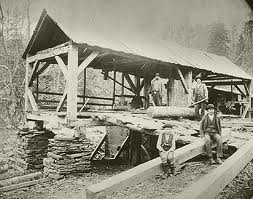 Wooleybah Sawmill, Pillaga
(NSW Heritage Office) Wooleybah Sawmill, Pillaga
(NSW Heritage Office)
.
Between the 1920’s and mid 1990’s, over 5 million railway sleepers were cut from ironbark grown in the Pilliga.

Ironbark is still used to produce fence posts and drops for electric fencing systems, where the non-conductivity of its heartwood provides a unique advantage.’ [Source: ^http://narrabri.net/Document1.aspx?id=1872]
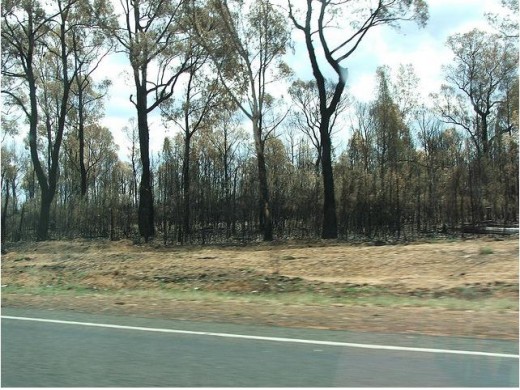 The Pilliga is susceptible to bushfire – by lighting, arsonists and incompetence.
[Source: clubr8255’s photostream, http://www.flickr.com/photos/32053650@N03/with/3038473001/ The Pilliga is susceptible to bushfire – by lighting, arsonists and incompetence.
[Source: clubr8255’s photostream, http://www.flickr.com/photos/32053650@N03/with/3038473001/
.
.
The endemic ‘Pilliga Mouse’
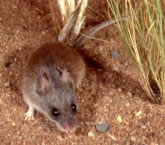
‘Endemic‘ means found naturally nowhere else on the planet.
The Pilliga Mouse (Pseudomys pilligaensis ) is a small native murid rodent found in the Pilliga Forests ecosystem. It is listed as Vulnerable in Australia and is endemic to the Pilliga Forests of New South Wales.
The Pilliga Mouse is very sparsely distributed and appears to prefer moist gullies, areas dominated by extensive coverage of low grasses and sedges, broombush and areas containing an understorey of kurricabah (Acacia burrowii) with a bloodwood (Corymbia trachyphloia) overstorey. It is nocturnal and appears to live in burrows.
Its main threats are from logging operations that destroy the understorey particularly broombush, inappropriate fire regimes (broadscale and frequent bushfire management), predation by ferals (foxes, cats and wild pigs/boars)
.
[Source: ^http://www.environment.gov.au/cgi-bin/sprat/public/publicspecies.pl?taxon_id=99]
.
.
The Pilliga… now threatened by Mining
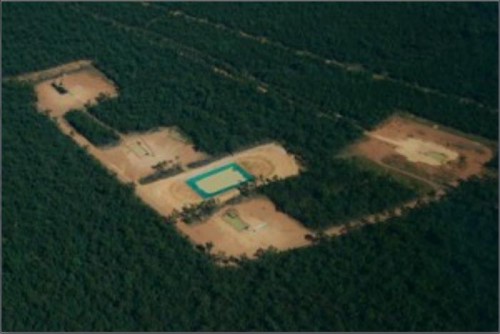
‘Eastern Star Gas coal seam expansion in Pilliga under federal investigation’
(Article on ABC Rural, 20110721, ^http://www.abc.net.au/rural/news/content/201107/s3274633.htm]
.
The Federal Government is investigating whether Eastern Star Gas is in breach of the Environment Protection Biodiversity Conseration Act at its coal seam gas project in NSW’s Pilliga forest.
The project is expected to result in the first large-scale coal seam gas operation in NSW. The Pilliga forest is the largest remaining temperate woodland in eastern Australia.
Chief Executive Officer of the National Conservation Council, Pepe Clark is calling on Santos, which owns Eastern Star Gas, to either desist or defer work until they have Federal approval.
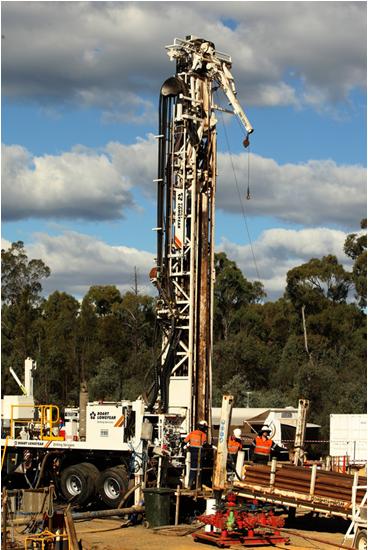 A Silhouette of Pillage
Eastern Star Gas’s coal seam gas development in the Pilliga State Forest, A Silhouette of Pillage
Eastern Star Gas’s coal seam gas development in the Pilliga State Forest,
which is having a profound effect on the Bohema creek water quality and flow which flows into the Murray River
© The Wilderness Society, Photo by Dean Sewell, May 2011
.
.
‘Pilliga coal seam gas developments breach Federal environmental law: report’
(Article by Nature Conservation Council of NSW, 20110719, ^http://www.nccnsw.org.au/media/pilliga-coal-seam-gas-developments-breach-federal-environmental-law-report)
.
‘Eastern Star Gas has conducted coal seam gas exploration and production activities in the Pilliga forest without seeking federal assessment on matters of national environmental significance, according to a report by the Northern Inland Council for the Environment, The Wilderness Society and the Nature Conservation Council of NSW.
The report, Under the Radar, was released today following the recent purchase of Eastern Star Gas by one of Australia’s largest domestic gas producers, Santos.
 
“Eastern Star Gas has undertaken extensive coal seam gas exploration and production without seeking federal approval. This is likely to have damaged the habitat of iconic threatened species such as the Pilliga Mouse and the Regent Honeyeater,” said Warrick Jordan, Campaign Manager at the Wilderness Society Newcastle.
“Santos is taking on the most environmentally destructive and contentious gas project in NSW. As the new owner, Santos should look carefully at the damaging impacts of this proposal and immediately desist or refer all existing operations in the Pilliga for proper assessment.
“We are asking Tony Burke to immediately ‘call-in’ all existing Eastern Star Gas operations in the Pilliga under federal environment laws. Eastern Star should not be able to get away with destroying our natural heritage,” he said.
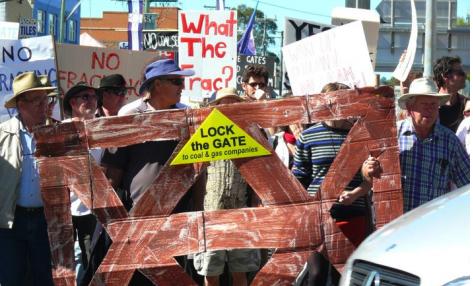
The Under the Radar report found coal seam gas operations in the Pilliga have cleared more than 150ha and fragmented 1,700ha of bushland, drilled 92 coal seam gas wells, constructed 56.6km of pipelines, and operated 35 production wells without seeking approval under the Federal EPBC Act. These activities have occurred in habitat for federally-listed threatened species, such as the South-Eastern Long-eared Bat.
“Under Commonwealth legislation, any potential impacts on nationally-threatened species must be referred to the Environment Department for approval. Eastern Star Gas has been flying under the radar to avoid this process in the Pilliga,” said Pepe Clarke, CEO of the Nature Conservation Council of NSW.
“Eastern Star has recently applied for Commonwealth approval for a large new coal seam gas field in the same area of the Pilliga as existing operations. If these future operations trigger federal environment laws, then so do the existing operations and Santos should immediately cease those operations and be refer them to the Federal Government”,” he said.
“The question remains, will Santos continue Eastern Star’s reckless attempts to turn the iconic Pilliga Forest into an industrial coal seam gas field? If Santos can’t be trusted to abide by environmental laws now, they cannot be trusted to manage the environmental impacts of NSW’ biggest coal seam gas development,” said Carmel Flint, of the Northern Inland Council for the Environment.
Under the Radar report summary
The Federal Environment Protection and Biodiversity Conservation Act 1999 (EPBC Act) makes it illegal to undertake an activity that has, or is likely to have, a significant impact on matters of national environment significance. These prohibitions are set down in Part 3 of the EPBC Act 1999, in s18 and s20 respectively.
There are at least 24 matters of national environmental significance, as defined by the EPBC Act, which occur within the Pilliga Forest section of the Eastern Star Gas Petroleum Exploration Licence 238 and Petroleum Assessment Lease 2. These include known, likely, and potential habitat for 15 nationally threatened species (4 endangered, 11 vulnerable), and known or potential habitat for 9 migratory birds listed under international conventions.
Environment groups have conducted a detailed assessment of the likely impacts of current coal seam gas activities in the Pilliga Forest on matters of national environmental significance, by applying the Guidelines for Significant Impact set down by the Department of Sustainability, Environment, Water, Population and Communities (SEWPaC). These are the same guidelines that should have been applied by Eastern Star Gas to assess the impacts of the activities.
The following coal seam gas activities have been undertaken in PEL 238 and PAL2:
1. The drilling and on-going management of more than 92 coal seam gas bores and coreholes
2. The conduct of 482km of seismic surveys
3. The construction and management of 56.6km of gas and water gathering pipelines
4. The development and management of five production fields, encompassing 35 production bores
5. The construction and management of a gas-fired power station at Wilga Park, including an upgrade of the station from 10MW to 40MW
6. The construction and operation of 1 reverse osmosis unit
7. The construction and management of 13 major water treatment dams/impoundments and numerous drill ponds
8. The discharge of treated produced water into the Bohena Ck, part of the Murray-Darling Basin.
9. The bull-dozing of numerous roads and tracks to facilitate the construction and operation of works listed above.
None of these activities, nor the whole action combined, has ever been referred to the Federal Government for consideration of the likely impacts on federally-listed species under the EPBC Act 1999. There is no Federal approval in place for the action.
The environmental impacts of these activities include: direct destruction of at least 150ha of native vegetation that is habitat for federally-listed species; heavy fragmentation of an area of 1,700 ha of native vegetation leading to the spread of invasive species; creation of artificial watering points at more than 13 different locations representing a risk to wildlife; introducing numerous sources of pollution through the use of chemicals and the handling and disposal of produced water; direct alteration of the ecology of a creek system for up to 22km; increased fire ignition sources and introduction of a flammable gas into an already fire prone environment; an overall disturbance footprint across 44,700ha of bushland.
Applying the Guidelines for Significant Impact, the report concludes that the impacts on federally-listed species are likely to be significant because of the intensity at which they have occurred, as well as:
- The extraordinary national and international conservation significance of the environment in which it is occurring;
- The sensitivity of the ecosystem given the scale of extinctions that have already occurred in the mammal fauna and the scale of decline now evident in the bird fauna;
- The substantial geographic area affected;
- The high cumulative impact in the context of other threats (other mining and gas developments, background clearing rates, climate change, invasive species, logging, and high intensity and frequent fires);
- The low level of confidence with which the impacts are understood; and
- the context in which it occurs of a heavily cleared and highly fragmented landscape with very low levels of reservation.
- The measures put in place by Eastern Star Gas to avoid or mitigate impacts are inadequate to prevent such impacts, and their effectiveness is uncertain and not scientifically established.
..
.
‘Farmers see threat in $900m Santos buyout’
(Article by Ben Cubby and Brian Robins, in Sydney Morning Herald, 20110719, ^http://www.smh.com.au/environment/farmers-see-threat-in-900m-santos-buyout-20110718-1hlq7.html)
.
‘A GAS exploration company chaired by the former deputy prime minister John Anderson will be bought out for $900 million, in a move expected to pave the way for the first large-scale coal seam gas drilling operation in NSW.
The resources giant Santos will buy Mr Anderson’s Eastern Star Gas, which has plans to drill more than 500 gas wells in the Pilliga scrub, near Narrabri, the largest surviving remnant of temperate woodland in eastern Australia.
The plan has already sparked fierce resistance from some farmers, who have said they will lock their gates rather than allow drilling rigs on their grazing land. Many are concerned that the controversial fracking technique, which can lead to groundwater contamination, will be used.
Santos said it recognised the objections people had to coal seam gas drilling, and would campaign to win public support.
”We are confident these issues can be addressed,” said the chief executive, David Knox. ”We’re going to set the right pace and bring [the community] along, as we prove things up … We recognise the criticality of working with local communities.”
Last month Santos launched a television advertising campaign, saying that coal seam gas was ”a fuel for the future” and that the company had previously forged good relationships with rural land-holders.
Mr Knox said the federal government’s introduction of a carbon price would increase demand for gas instead of coal, which generally had higher greenhouse gas emissions.
The acquisition will make Santos the state’s biggest holder of coal seam gasfields.
Opponents say the construction of hundreds of wells, and a network of roads linking them, would industrialise the landscape. ”What’s being allowed here is an uncontrolled experiment on the Australian environment,” said Drew Hutton, a campaigner with the anti-coal seam gas group Lock the Gate Alliance.
Initial surveys prepared for Eastern Star indicate the area is home to many threatened animal and plant species, including the Pilliga mouse, black-striped wallaby, glossy black cockatoo, painted honeyeater and barking owl.
From the beginning of June the Moree Plains Shire Council has placed a 60-day moratorium on seismic surveys, drilling or exploration for coal seam gas, to allow the council and community time to study the implications of proposals.
A report produced by the Wilderness Society said the project was of national significance and should be independently assessed by the federal Environment Minister, Tony Burke.
“The Pilliga project, if it proceeds, will have a devastating impact on the environment,” said a Wilderness Society campaigner, Warrick Jordan.
”It will clear 2410 hectares of valuable bushland across the eastern Pilliga, including in a state conservation area, pose risks to the Great Artesian Basin, produce massive amounts of saline water, and the associated pipelines and wells will impact surrounding agricultural areas.”
The Nature Conservation Council of NSW also said that work already done on the site meant it should be referred to the federal government.
Tony Pickard, a farmer whose land falls within the proposed gas well area, said the first he had heard of the proposal was on a government website that showed dots on his land representing gas wells. Mr Pickard has vowed not to allow drilling on his land.
A NSW Greens MP, Jeremy Buckingham, is travelling through the state speaking to people who oppose coal seam gas extraction.
”To have an energy giant like Santos move in and take over means that the project is much more likely to go ahead,” Mr Buckingham said.
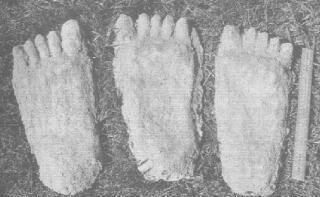 Santos footprints in The Pilliga Santos footprints in The Pilliga
.
‘Under the Radar – new report lifts the lid on Eastern Star Gas operations’
– Article by The Wilderness Society, [Source: ^http://www.wilderness.org.au/campaigns/coal-seam-gas/under-the-radar-new-report-lifts-the-lid-on-eastern-star-gas-operations]
.
‘Eastern Star Gas has been trashing parts of the Pilliga since 2004, avoiding environmental laws in the process. A new report by the Wilderness Society, the Northern Inland Council for the Environment, and the Nature Conservation Council has exposed this scandal.
The Pilliga Forest is home to a host of threatened species, including the Pilliga Mouse and the Regent Honeyeater. Many of these species are listed under the federal Environmental Protection and Biodiversity Conservation Act.
When a company wants to develop a project on a site with nationally listed threatened species, they are required by law to refer the project to the federal environment department.
Eastern Star Gas has been exploring for and producing coal seam gas in the Pilliga Forest since 2004. This has resulted, amongst other actions, in the clearing of 150 hectares of forest, fragmentation of a further 1700 hectares, and the dumping of waste water into creeks.
The ‘Under the Radar‘ (1.35MB – pdf) report concludes that Eastern Star Gas has impacted threatened species habitat, and should have sought federal environmental assessment for its operations. All current and proposed activities should be suspended, and assessed by the Commonwealth Environment Department.
Eastern Star Gas, after ignoring environmental legislation, now wants to build the biggest coal seam gas project in NSW in the Pilliga. They promote this destructive project as environmentally friendly and well managed.
Eastern Star has been exposed as a company that will get away with what it can if it thinks no-one is looking.
Well, now we are watching, and we’ll be ensuring, with your help, that the unique Pilliga Forest won’t become an industrial wasteland.’
.
.
‘A national treasure or an industrial wasteland?’
– Article by Carmel Flint in the Colong Bulletin, No. 241, July 2011, pp.1-2, reproduced with premission of The Colong Foundation for Wilderness, Inc.
.
Coal seam gas has recently emerged as a massive threat to the future of the Pilliga Forest, in north-west NSW. The Pilliga is located between Narrabri and Coonabarabran, and covers an extraordinary 500,000 hectares of intact and contiguous bushland.
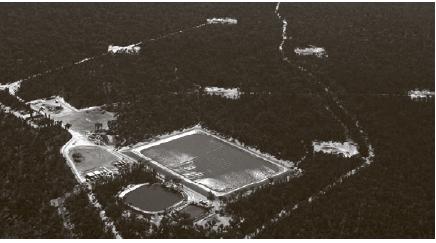 The Bibblewindi water pollution ponds are one of ten constructed during the Pilliga ‘exploration’ phase.
So far there are 1,100 well heads planned for gas extraction just in the eastern quarter of the Pilliga alone.
Photo: T Pickard The Bibblewindi water pollution ponds are one of ten constructed during the Pilliga ‘exploration’ phase.
So far there are 1,100 well heads planned for gas extraction just in the eastern quarter of the Pilliga alone.
Photo: T Pickard
One tends to run out of superlatives very quickly when it comes to the conservation significance of the Pilliga.
It is the largest temperate woodland left in eastern Australia and the southern recharge area for the Great Artesian Basin. It’s surface waters flow into the rivers of the Murray-Darling Basin. It is the single most important biodiversity refuge area remaining in the NSW Wheat-Sheep Belt.
The Pilliga is home to more than 25 threatened or migratory species that are listed under federal laws and at least 48 threatened species under NSW law. It includes the only known population of the endemic Pilliga Mouse, the largest Koala population in western NSW and the only known Black-striped Wallaby population in western NSW. It represents the national stronghold for populations of the Barking Owl and the Southeastern Long-eared Bat within eastern Australia.
It is an internationally recognised Important Bird Area, with particular significance for the Painted Honeyeater and Diamond Firetail. It is also recognised as an important part of the East Australian Bird Migration System, and is located in the Brigalow Belt South bioregion which is one of only 15 biodiversity hotspots recognised by the Federal Government across the nation. It is mostly public land, either State Forest, State Conservation Area or National Park, and it has recognised wilderness values.
Coal seam gas companies have been conducting exploration in the Pilliga for about 10 years now, and they have already done considerable damage. Under the guise of exploration, they have to date drilled 92 coal seam gas wells, constructed 46.2km of pipelines, conducted 394.2km of seismic surveys, constructed 1 gas compression station and 1 reverse osmosis unit, developed five pilot production fields encompassing 35 boreholes, produced and delivered gas to a local power station, constructed
10 major water treatment dams/impoundments, discharged produced water into a local creek system and bulldozed numerous roads and tracks. This, however, is just the tip of the iceberg. In April this year Eastern Star Gas applied to the Federal Government for
an environmental approval to move to full production in the Pilliga Forest.
They want to put in 1,100 wellheads and 1,000km of pipelines across the eastern section of the Pilliga, clearing at least 2,410 hectares and fragmenting 85,000 hectares.
.
Associated with this proposal are two pipelines – one to a proposed gas-fired power station at Wellington and another to a proposed new LNG export facility at Newcastle. By incorporating the first ever major LNG export facility, this Pilliga proposal will effectively open up the whole state to a massive expansion in coal seam gas. And, if that is not enough, it is very clear that this is only the beginning of the project. Having reviewed the data on coal seam gas potential across the companies full exploration licence (PEL238) we estimate that they will ultimately drill 7,100 boreholes, develop 7,000km of pipeline and clear more than 8,000 hectares of land across the Pilliga Forest and farmlands to the north.
Coal seam gas will destroy, fragment and degrade the integrity of this natural treasure. It will transform a thriving, living ecosystem into a heavy industrial zone with massive impacts on fauna and flora. It will dramatically increase fire risk and forever
change the nature of this wildflower wonderland.
.
If you don’t accept such an appalling transformation, then please act now to do something about it.
Email carmelflint@tpg.com.au to get involved and keep updated on what you can do.
.
.
.
Further Reading:
.
[1] ‘Under the Radar: How Coal Seam Gas Mining in the Pilliga is impacting matters of national environmental significance‘, 201106, a joint publication by The Wilderness Society Newcastle, The Nature Conservation Council of NSW and Northern Inland Council for the Environment. [>Open PDF document]
[2] ^http://en.wikipedia.org/wiki/Pilliga_forest,
[3] ^http://narrabri.net/Document1.aspx?id=1872
[4] ^http://huntervalleyjournal.blogspot.com/2010_02_01_archive.html
[5] ^http://www.nccnsw.org.au/media/pilliga-coal-seam-gas-developments-breach-federal-environmental-law-report
[6] ‘A Million Wild Acres’, 1981, by Eric Rolls, $32.95, GHR Press, ^http://ghrpress.com/shoppingcart/index.php?main_page=product_info&products_id=7
.
‘Thirty years ago, a bomb landed in the field of Australian consciousness of itself and its land in the form of Eric Rolls’ A Million Wild Acres. The ensuing explosion has caused extensive and heated debate ever since amongst historians, ecologists, environmentalists, poets and writers. Now reprinted in a commemorative 30th Anniversary Edition for a new generation of readers and against the backdrop of renewed and urgent concern about climate change, it includes Tom Griffiths’ seminal essay, The Writing of A Million Wild Acres, and a foreword by Les Murray drawn from his work Eric Rolls and the Golden Disobedience.
Here is a contentious story of men and their passion for land; of occupation and settlement; of destruction and growth. By following the tracks of these pioneers who crossed the Blue Mountains into northern New South Wales, Eric Rolls – poet, farmer and self-taught naturalist – has written the history of European settlement in Australia. He evokes the ruthlessness and determination of the first settlers who worked the land — a land they knew little about.
Rolls has re-written the history of settlement and destroyed the argument that Australia’s present dense eucalypt forests are the remnants of 200 years of energetic clearing.
Neither education nor social advantage decided the success of the first settlers, or those squatters, selectors, stockmen and timber getters who helped grow the Pilliga forest. Few men were more violent than John Macarthur, few rogues more vigorous than William Cox, few statesmen more self-seeking than William Wentworth.
Rolls’ environment teems with wildlife, with plants and trees, with feral pigs; with the marvellous interaction of insects and plants, rare animals and birds. The lovely tangle which is the modern forest comes to life as Rolls reflects on soils, living conditions, breeding and ecology.
Winner of the prestigious Age Book of the Year Award, A Million Wild Acres is also an important account of the long-term effect man – both black and white – has had upon the forest.’
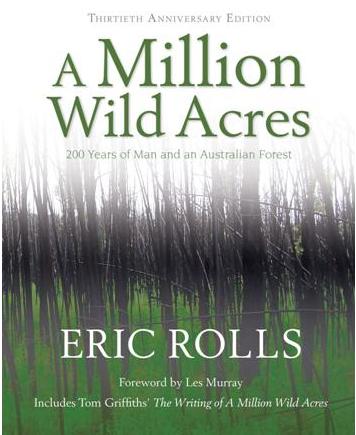
“The story of the Pilliga forest is one of advance, disappointment and retreat by pastoralists and then by small farmers“. [Les Murray]
May Santos and its Eastern Star Gas venture follow suit and show The Pilliga the respect it so long deserves.
.
.
.
Related Reading:
.
[1] Wollembi Valley Against Gas Extraction,
^http://wage.org.au/news/
.
.
[2] The Permaculture Research Institute of Australia, ‘Save Pilliga – NSW’s Largest Temperate Woodland’,
^http://permaculture.org.au/2011/05/25/save-pilliga-nsws-largest-temperate-woodland/
‘Save Pilliga – NSW’s Largest Temperate Woodland’
— by Cate Faehrmann May 25, 2011
Introduction
Eastern Star Gas has applied for approval under both state and federal regulations to develop a massive coal seam gas field of around 550 gas wells in the State Forests of The Pilliga. Commonly known as the ‘Pilliga Scrub’, this unique woodland is near Narrabri in northern NSW. The gas project is set to clear over 2,400 hectares of native vegetation and will forever change the landscape of the Pilliga.
The Pilliga Scrub is a highly significant area in terms of the state’s biodiversity. It is known to be the largest continuous remnant of semi-arid woodland in temperate New South Wales and contains many threatened animal and plant species such as the Pilliga Mouse, Black-striped Wallaby and South-eastern Long-eared Bat.
Email the Minister now and ask him to protect the Pilliga Scrub from coal seam gas.
Black-striped Wallaby, a mostly nocturnal animal under threat from land clearing, and now, coal seam gas.
The gas field and the related infrastructure proposals (including two major regional pipelines) have been determined to be ‘controlled actions’ under the Environment Protection and Biodiversity Conservation (EPBC) Act. This means they will require the approval of Minister Tony Burke and the Federal Department of Environment. There is also a proposal from Eastern Star Gas being referred for a LNG export processing facility at Kooragang Island at Newcastle.
At the NSW Government level, the projects are being assessed by the Department of Planning under Part3A. The Director General’s Requirements (DGRs) for the environmental assessments were issued in December 2010, but this was not made public until after the recent state election. You can view them here.
This is the biggest coal seam gas field ever proposed in NSW and the first ever LNG export facility in the state. However, it looks to be just the beginning. Eastern Star Gas, headed by former Nationals Leader and Deputy Prime Minister John Anderson, has not revealed their full plans for the area. Coal seams extend underneath almost the entire Pilliga Scrub, and this initial proposal covers 85,000ha of a 500,000ha vegetation remnant. Extrapolating these figures, 550 wells now could mean as many as 3,000 wells in the future. You can read more about the EPBC referrals for the Narrabri Gas Field here at the Federal Environment Department’s website.
The four project components
- Development of a major coal seam gas field in the Pilliga Scrub
- A pipeline from Narrabri to Wellington (via Coolah)
- A pipeline from Coolah to Newcastle
- An LNG export facility at Kooragang Island at Newcastle
Existing activities
Eastern Star Gas Limited (ESG) is the operator of the Narrabri CSG Joint Venture (NJV). Some 35% of the CSG interest in PEL 238 is strata titled to Santos. The Chairman of ESG is John Anderson, former National Party politician. The Narrabri Coal Seam Gas Project is being developed by the NJV.
ESG developed the Wilga Park Power Station in 2004, and supplied it with gas from the Coonarah Gas Field on private land to the north of the Pilliga.
In 2006, a number of closely spaced well production pilots were developed in the Bohena and Bibblewindi fields in the Pilliga Scrub. In 2008, approval was granted for a gas pipeline from the pilot wells in the Pilliga to the Wilga Park Power Station and the expansion of the power station. The expected supply of gas from the Coonarah Gas fields did not eventuate, and the station has been utilising production gas from the pilot wells. The NJV currently has an MOU with ERM Power for the provision of gas to a new gas fired power station at Wellington over a 20 year period commencing in 2013.
Gas field development
The proposed gas field development area covers approximately 85,000 ha and includes Pilliga East State Forest, Bibblewindi State Forest, Jacks Creek State Forest, and Pilliga East State Conservation Area, plus some small areas of Crown Land and private land. The project aims to produce, process, compress and transport CSG from within Petroleum Exploration Licence 238, Petroleum Production Lease 3 and Petroleum Assessment Lease 2.
The project proposal includes the following:
- 550 production well sets, initially, on a 500m spacing
- 1,000 km of gas and water gathering systems (ie pipelines)
- access tracks (through the Pilliga Forests)
- a co-located gas processing and compression plant
- a centralised water management facility
- Ancillary infrastructure such as offices and workshops.
Impacts
The gas production will clear at least 2,410 hectares of native vegetation!
The area that is being targeted includes:
- A rich variety of heritage sites, including a rock shelter, burials, a grinding groove, scarred trees, open sites, stone artefact scatters and isolated finds.
- An Internationally recognised Important Bird Area.
- Known or likely habitat for 25 nationally listed threatened species and five nationally listed Endangered Ecological Communities.
- Known or likely habitat for 48 state-listed threatened species and five state-listed Endangered Ecological Communities including:
- Pilliga Mouse – known only from the Pilliga Scrub, this nationally vulnerable species has a total distribution of only 100,000 hectares. It will be severely impacted by the direct habitat loss, increased predation, and fragmentation leading to impacts on dispersal.
- Black-striped Wallaby – endangered in NSW, the northern Pilliga is the only known location of this species in western NSW. Requiring dense vegetation, it is extremely vulnerable to clearing, fragmentation and increased predation.
- Malleefowl – considered endangered in NSW and nationally vulnerable, has been recorded previously in eastern Pilliga. It is highly vulnerable to increased predation and fire.
- South-eastern Long-eared Bat – the Pilliga Scrub is recognised as the likely national stronghold for this vulnerable species (NSW and Federal). It prefers large, intact stands of native vegetation, and is at risk of fragmentation, loss of hollow trees, and uncovered saline ponds. Numerous other threatened bat species face similar risks from the proposal.
- Glossy Black Cockatoo – a very significant western population of the Glossy Black Cockatoo occurs in the Pilliga Scrub.
- Squirrel Glider, Koala and Eastern Pygmy Possum – which are all likely to be severely impacted by the direct habitat loss, fragmentation (and particularly its impacts on mobility and dispersal), and increased predation.
- Grey-crowned Babbler, Diamond Firetail, Hooded Robin, Speckled Warbler – and numerous other declining woodland birds for which the Pilliga represents a major refuge area. Those species are all threatened by increased fragmentation and predation.
- This area of the Pilliga Scrub is prone to severe, high intensity fires that burn very quickly through vast areas. The proposal to have a massive compressor facility located in the Pilliga, and 550 well production sets, represents a very serious fire risk and has the potential to render a regular Pilliga hot burn to a catastrophic level.
Water resources
The Eastern Star Gas proposal suggests that it intends to use lateral drilling rather than hydraulic fracturing (fracking), but it does not explicitly prohibit or rule it out. There is inadequate assessment of the impacts on groundwater and aquifers, including the Great Artesian Basin. The proposal is extremely vague as to what it plans to do with the water that is produced as a by-product of the extraction process. Currently it states that it will use “a combination of storage and evaporation with tertiary treatment and discharge (environmental flows) for co-produced water management”. Produced water contains a range of naturally occurring substances that are likely to be harmful to the environment and human health. It is highly saline, and can also contain toxic drilling and fracturing chemicals. Eastern Star Gas commits to the development of a Water Management Strategy, but in the absence of such a strategy it is not possible to assess the potential impacts on biodiversity or the environment of produced water.
Take action to save the Pilliga Scrub
The Pilliga campaign will no doubt be the next big fight to protect biodiversity in NSW. The coal seam gas industry is expanding rapidly, and governments are largely taking the advice of industry on the environmental impacts.
As a first step, please send a message to the Federal Environment Minister requesting he reject the project under the EPBC Act. You can write your own personal email by contacting him here. Or simply fill out the form here to send him a generic message.
As the Greens environment spokesperson, together with my colleague Jeremy Buckingham as the Greens mining spokesperson, we’ll be building a campaign to save the Pilliga from coal seam gas and to protect its unique biodiversity. Check back here soon for more information on how you can help save the Pilliga Scrub.
.
.
[3] Pilliga Nature Reserve
^http://www.environment.nsw.gov.au/nationalparks/parkHome.aspx?id=N0464
.
.
[4] GreenLeft, ‘Pilliga Forest new CSG battlefront‘
^http://www.greenleft.org.au/node/47934
‘Pilliga forest new CSG battlefront’
By Kate Ausburn, 20110618
.
The Pilliga State Forest in northern NSW will be turned into a gas field if the government approves Eastern Star Gas‘s (ESG) mining proposal for the region. The proposal set out by ESG seeks to develop the Pilliga into the state’s largest coal seam gas (CSG) project.
The development would include the drilling of more than 1000 gas wells and the clearing of vast stretches of native bushland to make way for gas pipelines and other associated infrastructure, such as a water treatment facility and access roads. ESG is already carrying out smaller scale gas development in the Pilliga, as the operator of the Narrabri CSG Joint Venture.
In 2006, ESG developed coal seam gas production pilot wells in the Pilliga. A gas pipeline was also approved and built to carry gas from these wells to the Wilga Park Power Station, which was built by ESG in 2004.
As well as the wells now used to produce gas, some capped, unused gas wells remain behind barbed wire fences in cleared areas of the Pilliga. At least one expansive pond holding wastewater produced by coal seam gas extraction sits amassing algae on its surface.
ESG’s plans for large-scale expansion of coal seam gas operations in the Pilliga have been criticised by environmental groups and landowners from the region.
The Greens NSW environment spokesperson Cate Faehrmann explained the scale of ESG’s proposal: “The proposed gas field development area covers approximately 85,000 hectares and includes Pilliga East State Forest, Bibblewindi State Forest, Jacks Creek State Forest, and Pilliga East State Conservation Area, plus some small areas of Crown Land and private land.”
Despite the NSW government’s recent introduction of “transitional agreements” to regulate the expanding coal seam gas industry, ESG’s Managing Director David Casey is hopeful about the future of his company’s proposal for the Pilliga.
In a May 25 Open Briefing document, Casey said ESG continues to “monitor opportunities and development pathways with a view to ensuring early commercialisation of the project for the benefit of shareholders …
“Currently, our best estimate is that Federal and NSW regulatory approvals will be in place … in early 2012.”
However, The Wilderness Society’s Warrick Jordan said on June 16 that “given the scale of the project and current uncertainty over NSW mining and planning policy” ESG’s timeline would be difficult to fulfil.
“Estimates of state and federal approval being in place in six months appear wildly optimistic,” he said.
“The assessment requires full community consultation and proper consideration of environmental impacts on 85,000 hectares of forest, 1600 km of pipeline, a RAMSAR wetland, the marine environment, and the Great Artesian Basin.”
Local community and environmental groups came together on June 9 to tour the Pilliga and discuss campaigning strategy to minimise risks associated with coal seam gas and safeguard the environmental integrity of the region.
The coalition of groups will combine their efforts to campaign against expansion of coal seam gas mining in the Pilliga.
The Wilderness Society said on June 16:
“The project area in the Pilliga is a recharge area for the Great Artesian Basin and includes habitat for threatened species, endangered ecological communities, and an area protected under legislation for its natural values.”
.
.
Links to articles on the dangers of Fracking Coal Seam Gas:
.
[5] ^http://www.thegreenpages.com.au/news/fracking-coal-seam-gas-may-poison-organic-farms/
[6] ^http://ntn.org.au/wp-content/uploads/2011/07/NTN-CSG-Report-July-2011.pdf
[7] ^http://www.envirowiki.info/Coal_seam_gas
[8] ^http://www.brisbanetimes.com.au/environment/energy-smart/origin-stops-coal-seam-gas-drilling-after-chemicals-found-in-water-20101020-16ud7.html
[9] ^http://www.perthnow.com.au/news/special-features/fracking-threatens-wa-water-resources/story-e6frg19l-1226010221897
[10] ^http://lockthegate.org.au/csg-facts/csg-factsheet.cfm
[11] ^http://dea.org.au/news/article/fracking_for_coal_gas_is_a_health_hazard
[12] ^http://theconversation.edu.au/coal-seam-gas-could-be-a-fracking-disaster-for-our-health-1493
.
.
.
Community Solidarity:
.
The Coal Seam Gas industry is selfishly exploiting Australian resources for corporate profit, much of which is channelled to foreign owners and investors offshore. In the process, coal seam gas exploration, drilling, fracking and the carcinogenic B-TEX chemicals used are destroying Australia’s natural environment and arable land – bulldozing habitat and spewing salt above ground, while below ground chemically poisoning Australia’s Great Artesian Basin and ground water. The industry is one of extreme discretionary greed and arrogance, perpetuating local environmental rape, pillage and plunder.
If you think your area is the only one concerned about coal seem gas , think again.
The following communities around Australia are being exploited by coal seam gas corporations:
-
Camden, NSW
-
Helensburgh and the Illawarra, NSW
-
Pilliga, NSW
-
Liverpool Plains, NSW
-
Wellington, NSW
-
Gunnedah Basin, NSW
-
Gloucester, NSW
-
Broke, NSW
-
Wollombi, NSW
-
Northern Rivers, NSW
-
Cooper Plains, SA,
-
Otways, Vic
-
Tara, Qld
-
Cecil Plains, Qld
-
Darling Downs, Qld
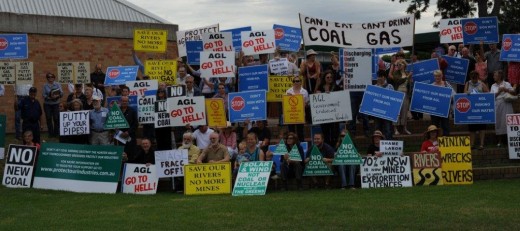
.
Follow similar community campaigns at the following links:
.
[1] ^http://www.gabpg.org.au/downs-farmers-challenge-csg-water-claims
[2] ^http://stop-csg-illawarra.org/
[3] ^http://www.keerronggassquad.org/
[4] ^http://www.stopcoalseamgas.com/
[5] ^http://www.kateausburn.com/2011/07/05/first-for-nsw-protest-stops-coal-seam-gas-rig/
[6] ^http://www.couriermail.com.au/news/queensland/tara-residents-blockade-queensland-gas-company-to-stop-seismic-testing/story-e6freoof-1225903149452
[7] ^http://lockthegate.org.au/tara/
[8] ^http://huntervalleyprotectionalliance.com/
[9] ^http://macarthur-chronicle-camden.whereilive.com.au/news/story/insert-web-head-here-62/
[10] ^http://www.zimbio.com/Australia/articles/P4B7C9pLq7Y/STOP+GLOUCESTER+Coal+Seam+Gas+Mining+near
(The above websites were accessed 20110809)
.
-end of article –
Tags: A Million Wild Acres, a silhouette of pillage, AGL, Apex Energy NL, B-TEX, Bringalow Belt South, Eastern Star Gas, former deputy prime minister John Anderson, fracking coal seam gas, Origin Energy, Pilliga Coal Seam Gas, Pilliga Forests, Pilliga Mouse, Pilliga yowie, Queensland Gas Company, Santos, the Pilliga, what the frack
Posted in Mice (native) and Antechinus, Pilliga (AU), Threats from Bushfire, Threats from Colonising Species, Threats from Deforestation, Threats from Mining | No Comments »
Add this post to Del.icio.us - Digg
|
|
 “VicForests log in endangered species habitat. They log old growth forests in East Gippsland and the central highlands”
“VicForests log in endangered species habitat. They log old growth forests in East Gippsland and the central highlands”  ‘Since I was appointed president of Nippon Paper Group, Inc. in 2008, I have been pursuing “growth-oriented management.” This means exploring every possibility with a consistently positive stance, actively seizing opportunities, achieving the growth needed to become one of the top pulp and paper companies worldwide, as set out in the Group Vision 2015, and developing corporate value that meets the expectations of all stakeholders.’ ~ President of Nippon Paper Group, Yoshio Haga. [Source: ^http://www.np-g.com/e/about/president.html]
‘Since I was appointed president of Nippon Paper Group, Inc. in 2008, I have been pursuing “growth-oriented management.” This means exploring every possibility with a consistently positive stance, actively seizing opportunities, achieving the growth needed to become one of the top pulp and paper companies worldwide, as set out in the Group Vision 2015, and developing corporate value that meets the expectations of all stakeholders.’ ~ President of Nippon Paper Group, Yoshio Haga. [Source: ^http://www.np-g.com/e/about/president.html]
 .
. Japan’s sacred Aokigahara Forest
Japan’s sacred Aokigahara Forest Stump of Brown Mountain’s sacred 600 year old Mountain Ash old growth tree.
It was logged by VicForests in November 2008 for Nippon Paper’s Reflex Paper.
Stump of Brown Mountain’s sacred 600 year old Mountain Ash old growth tree.
It was logged by VicForests in November 2008 for Nippon Paper’s Reflex Paper.














 ,
, 






 Woodchip train makes its way to Midways, Geelong (2009) for as little as $2.50 per tonne.
Photo: Wilderness Society Collection
Woodchip train makes its way to Midways, Geelong (2009) for as little as $2.50 per tonne.
Photo: Wilderness Society Collection










































